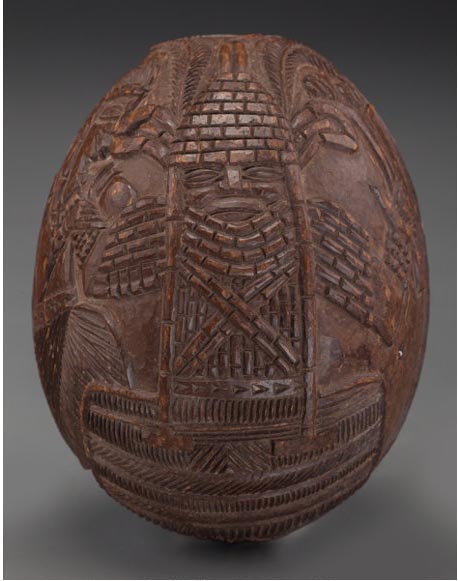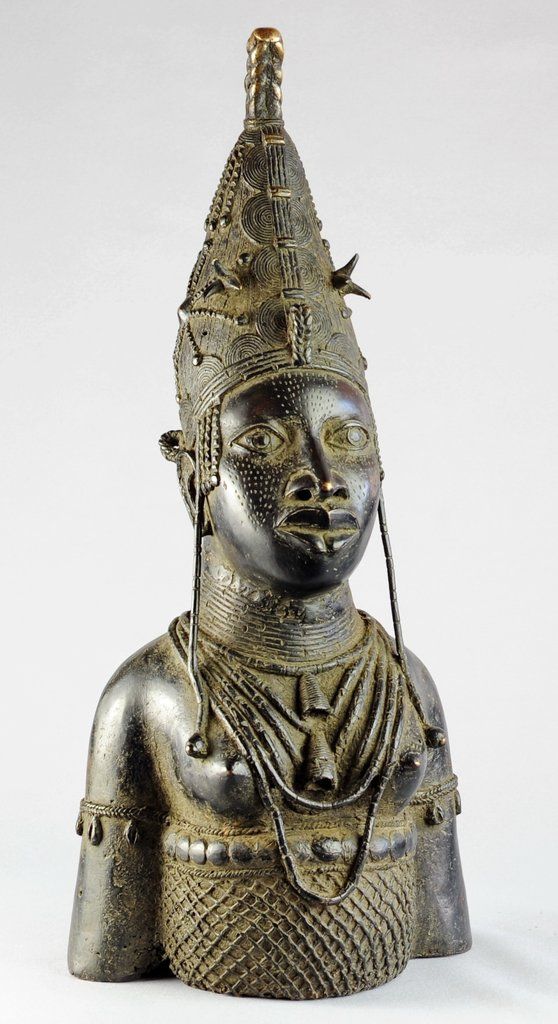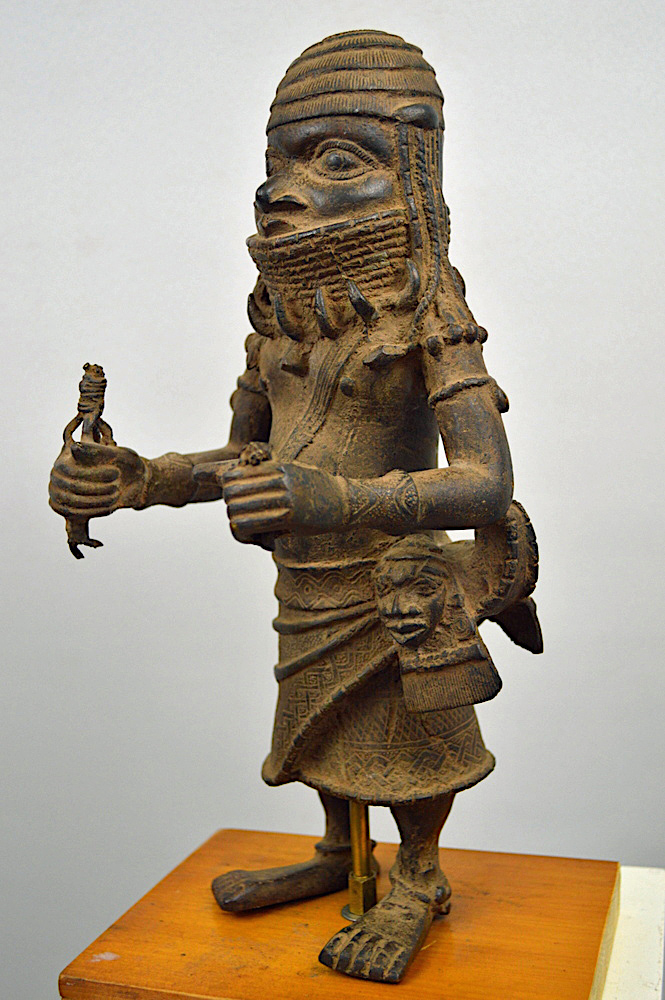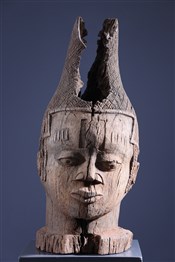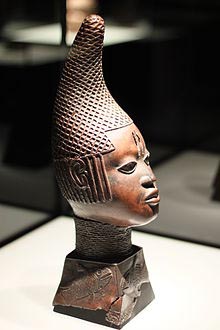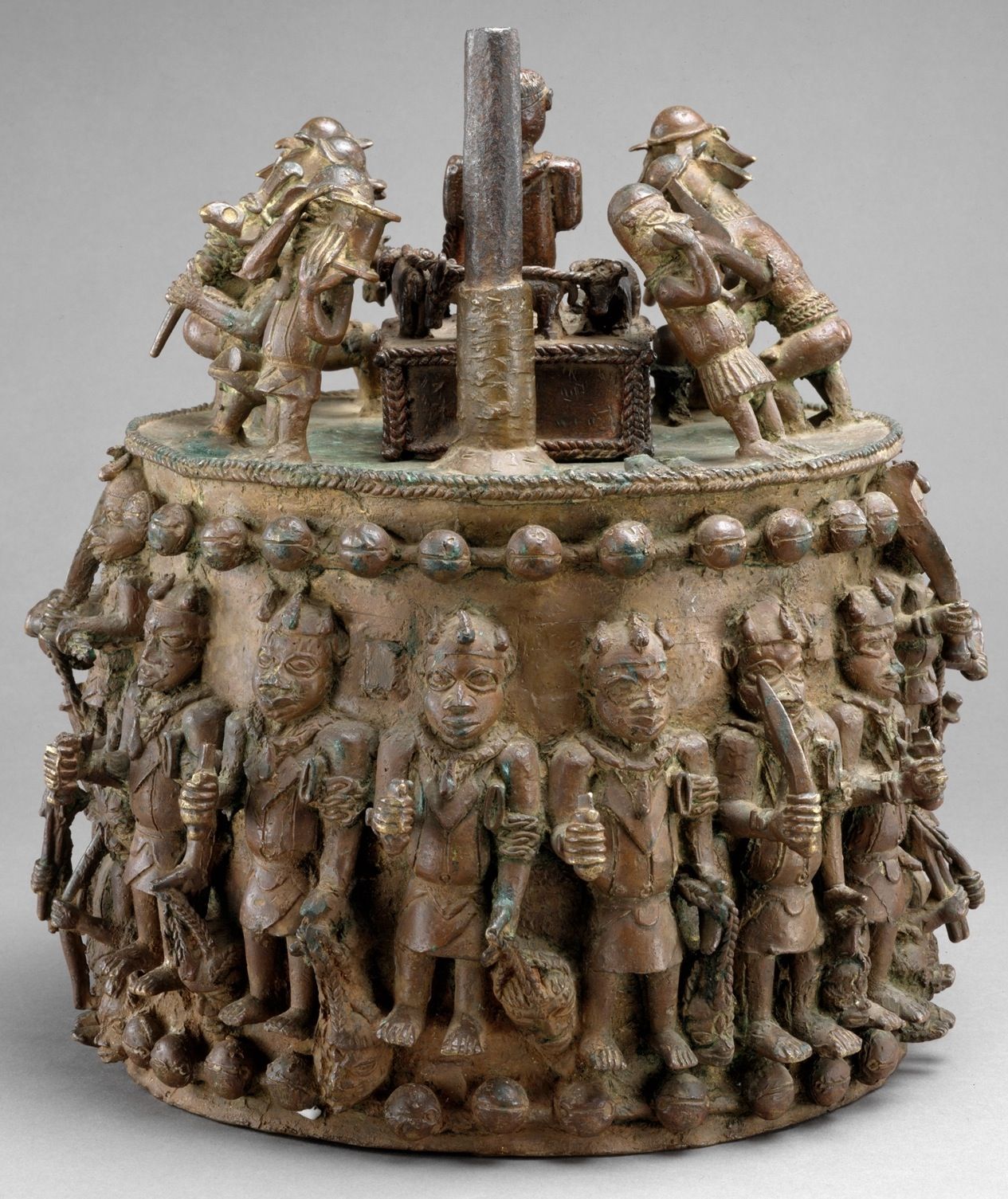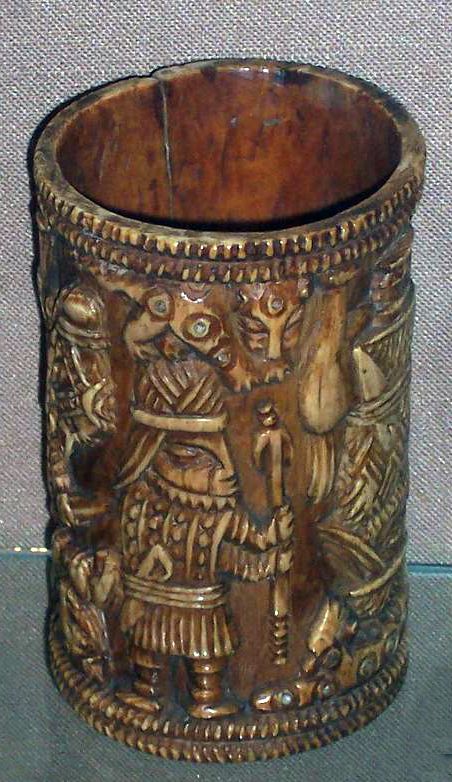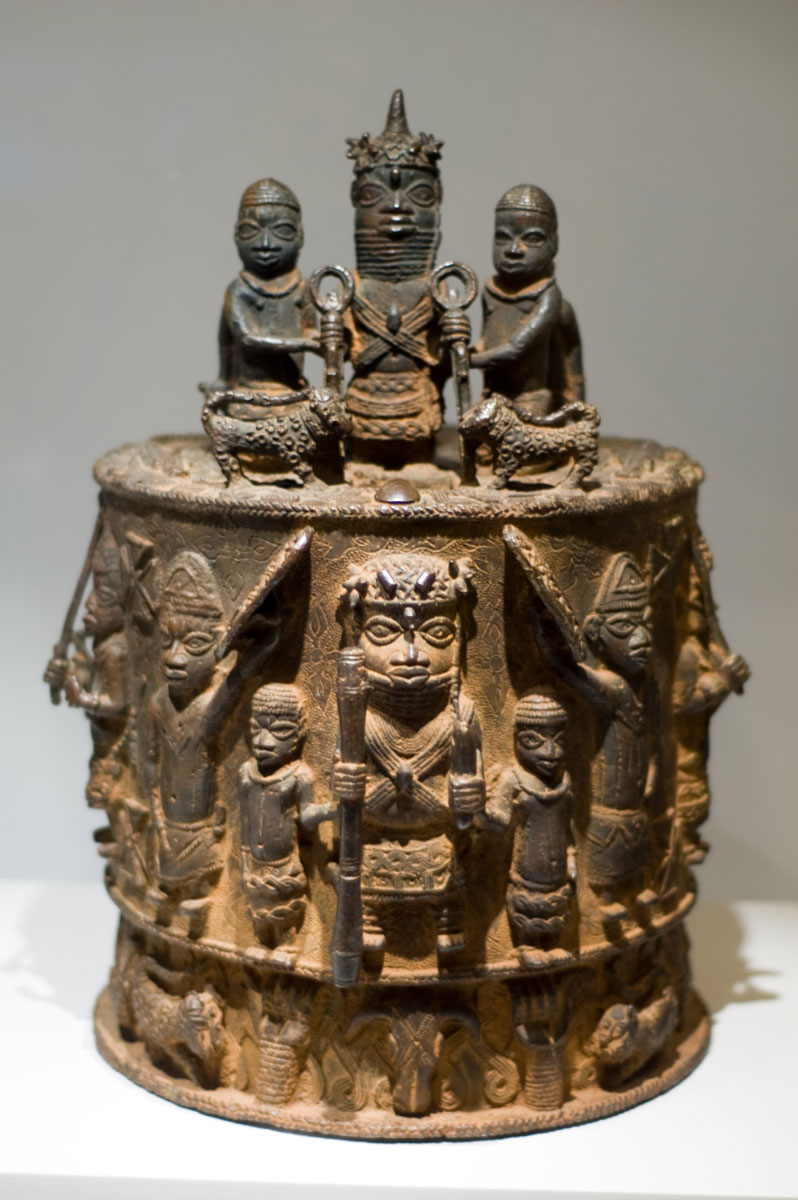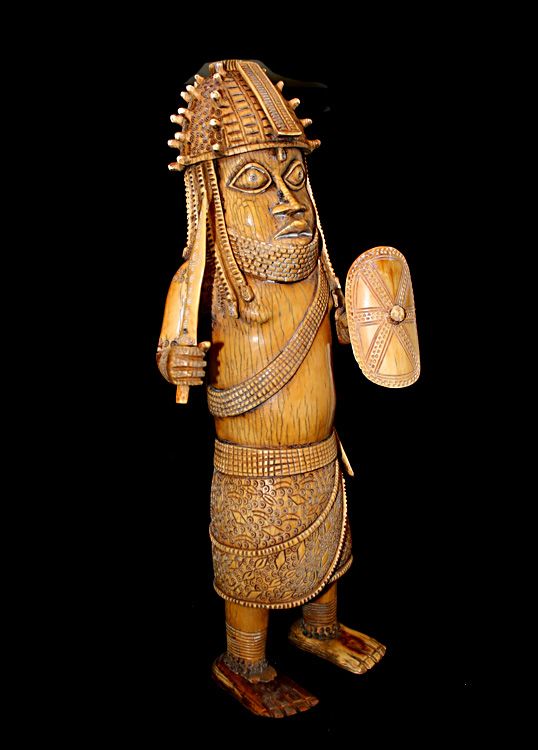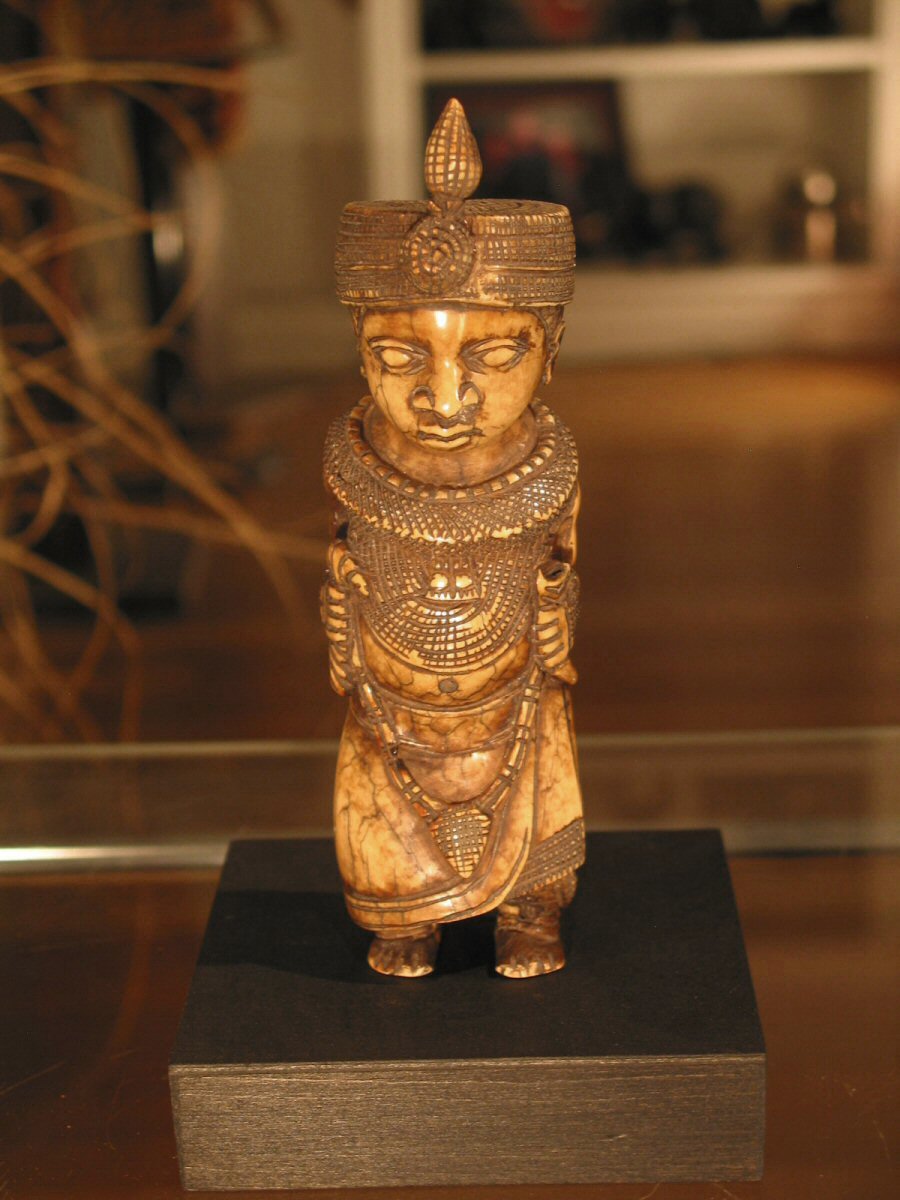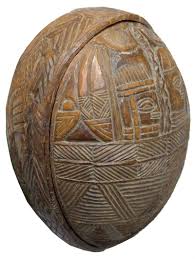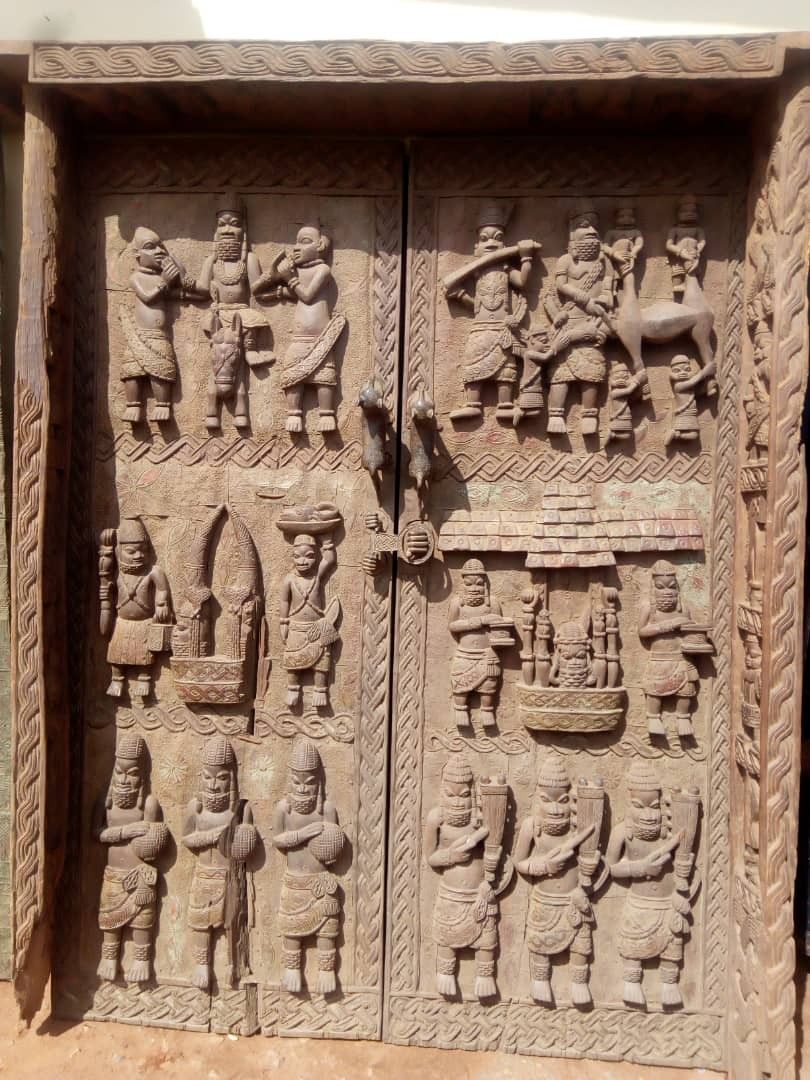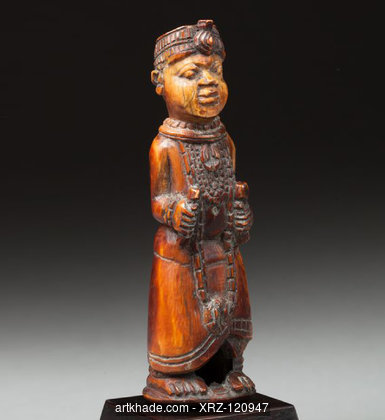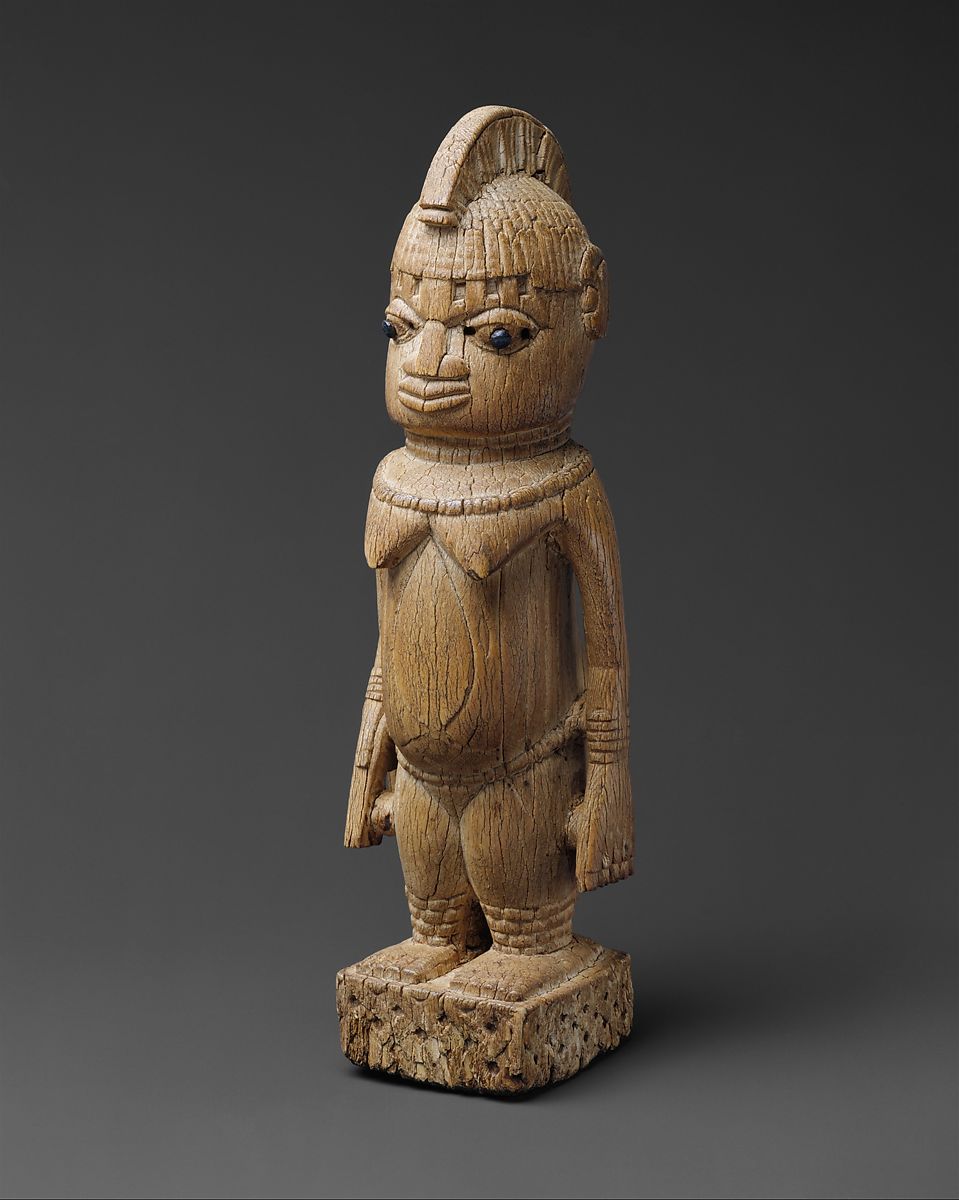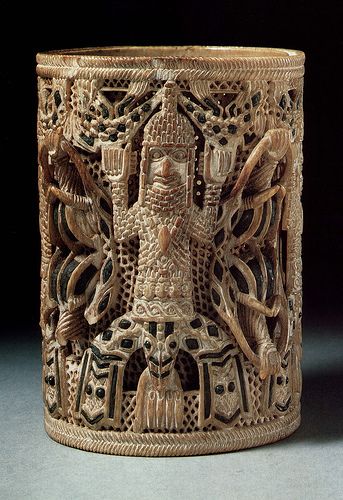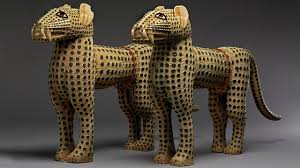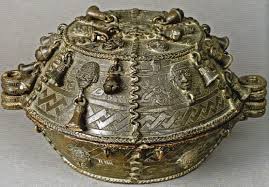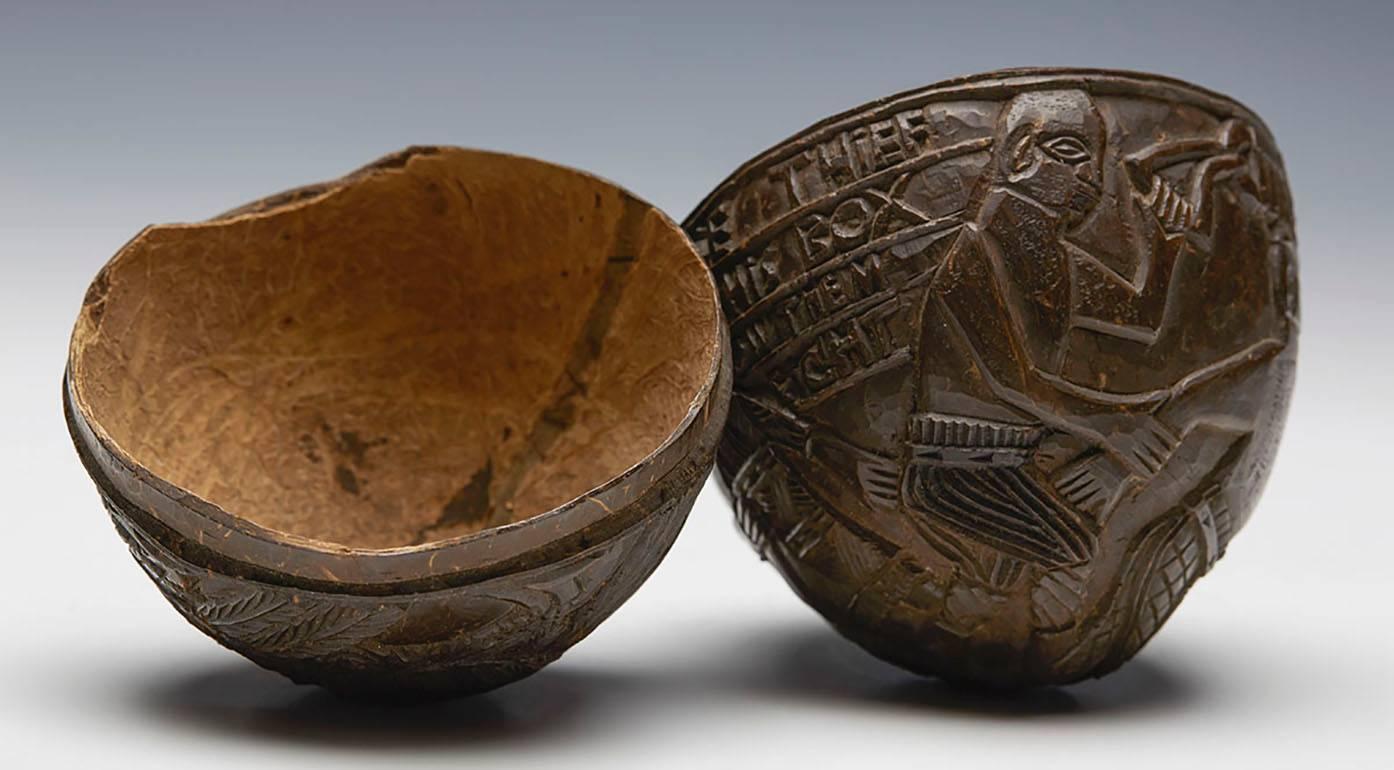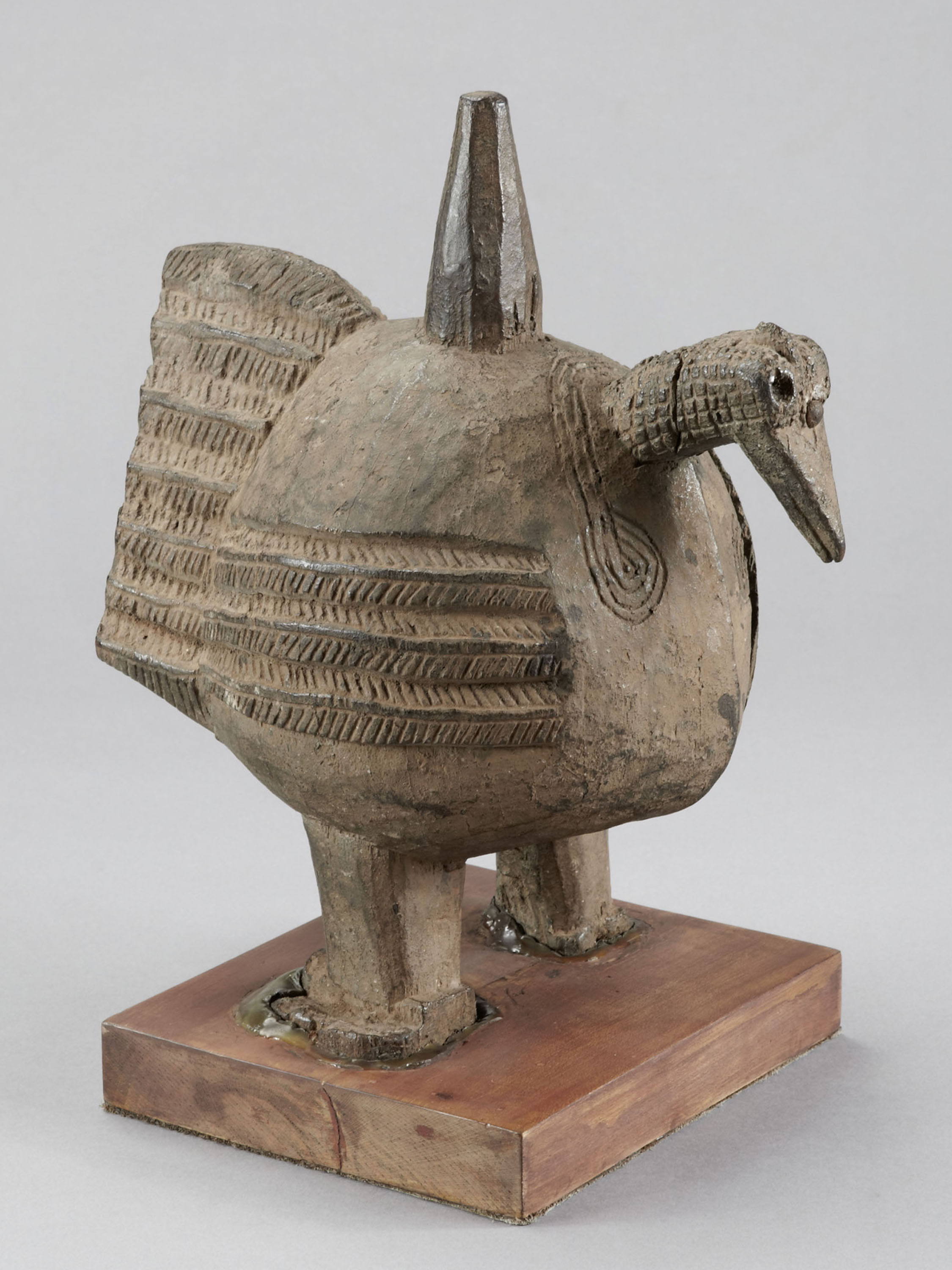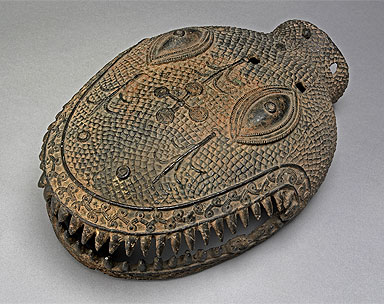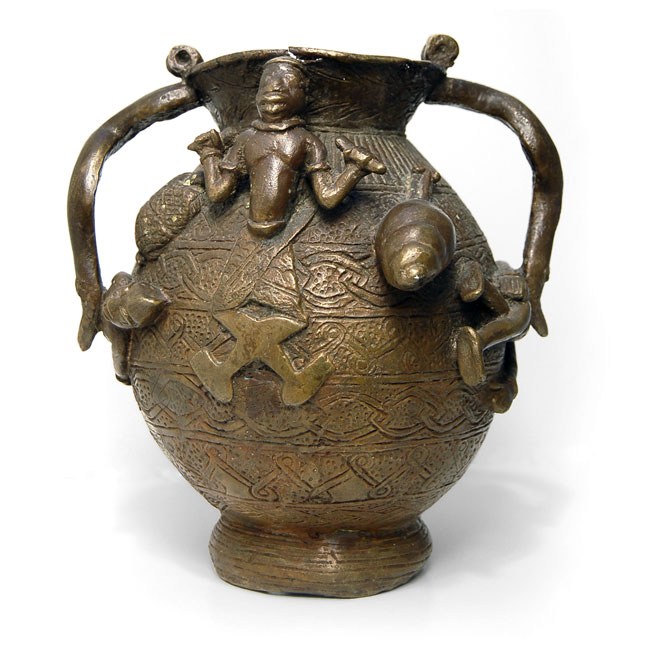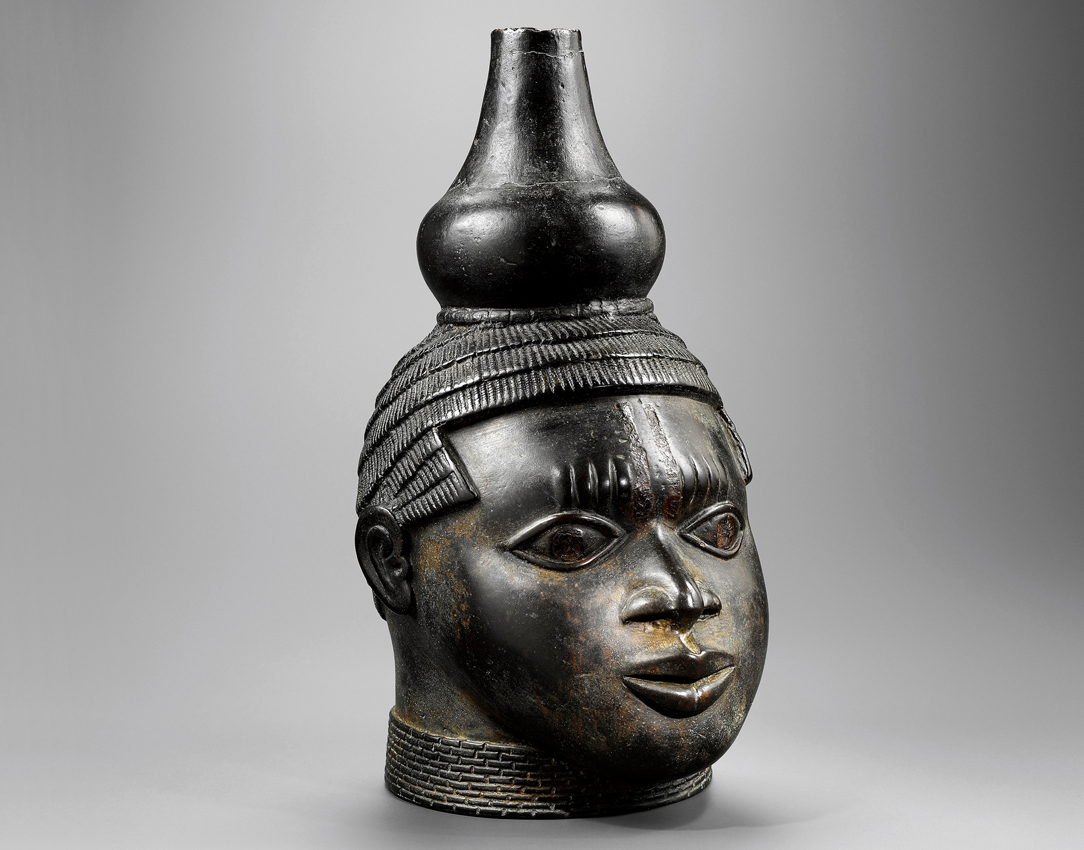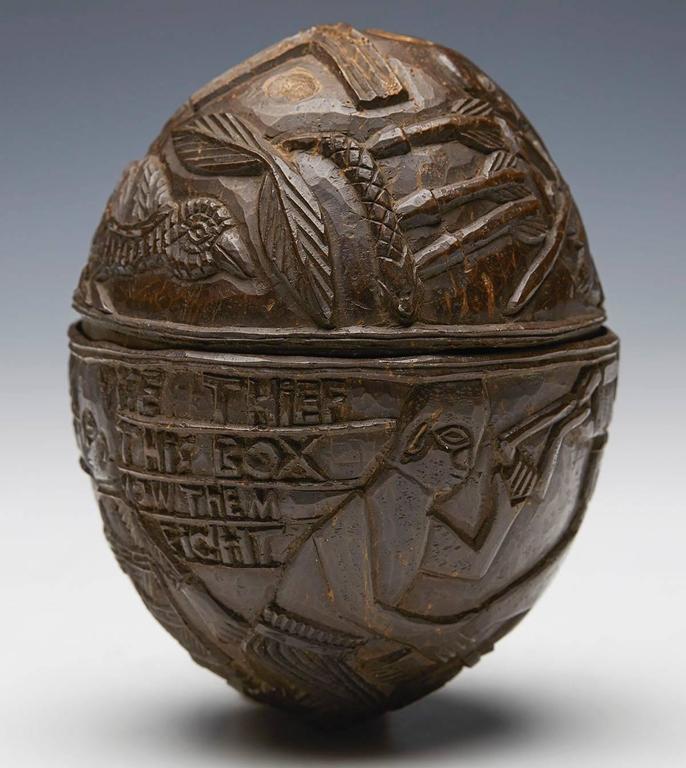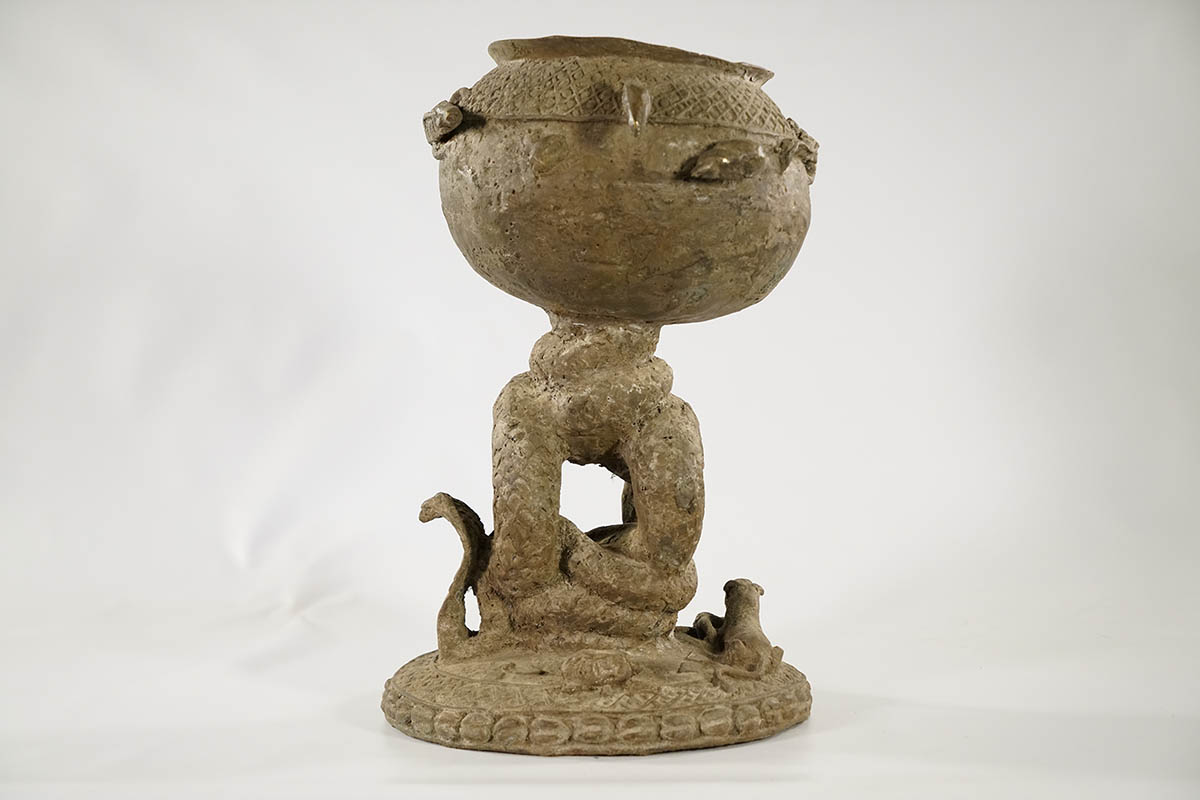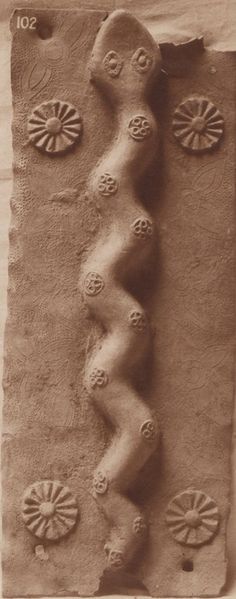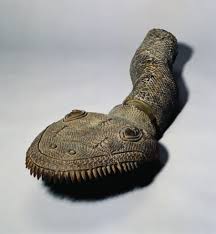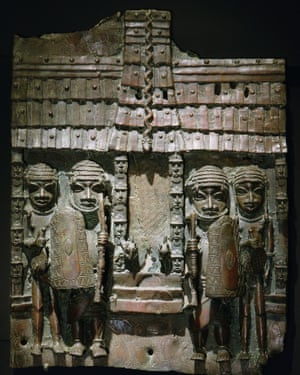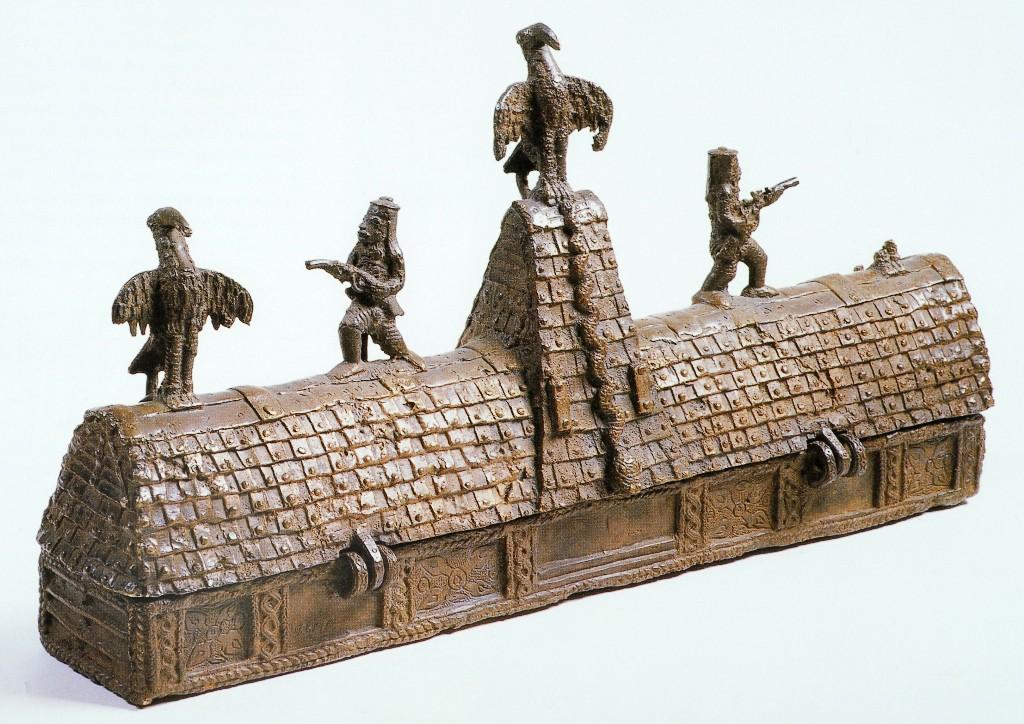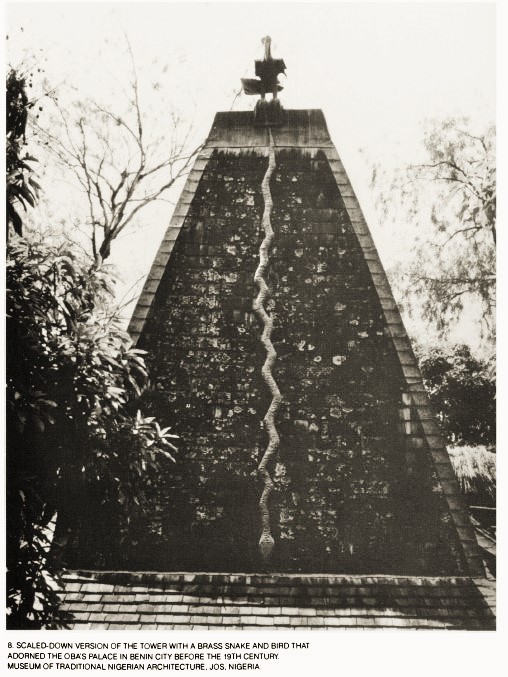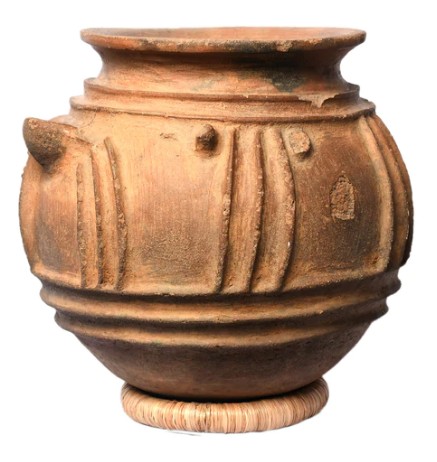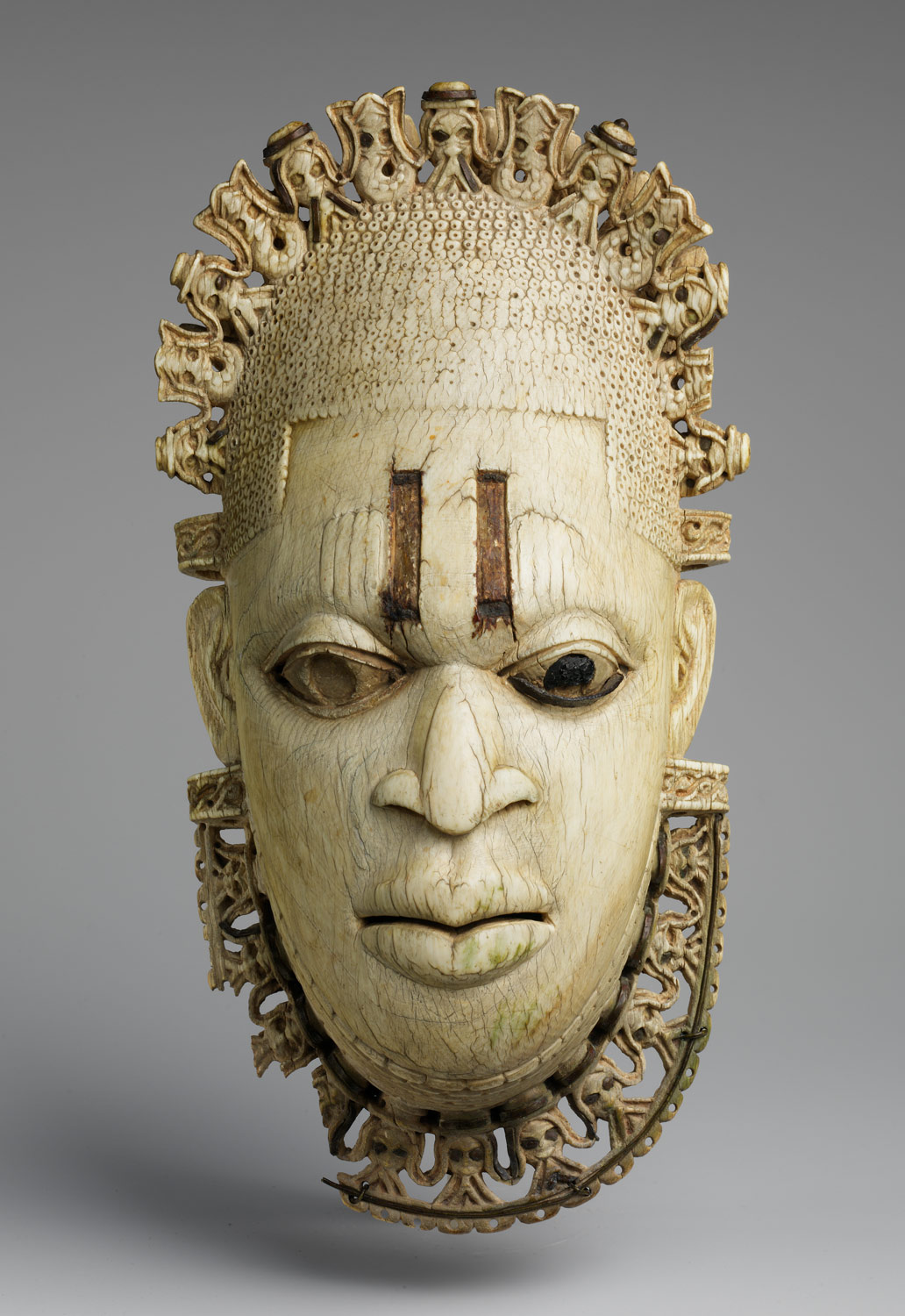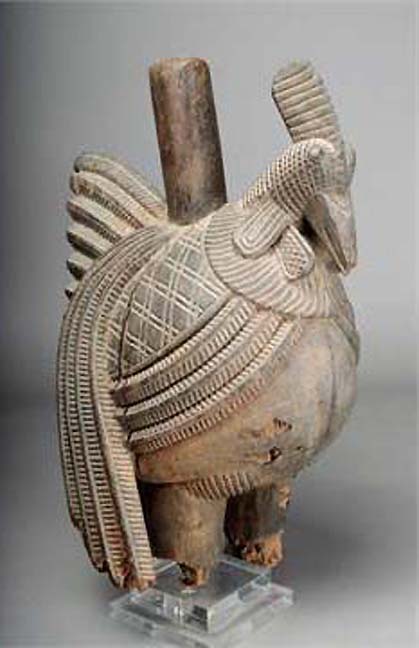EDO CITY ROYAL COURT ART of BRONZE & IVORY - WEST AFRICA
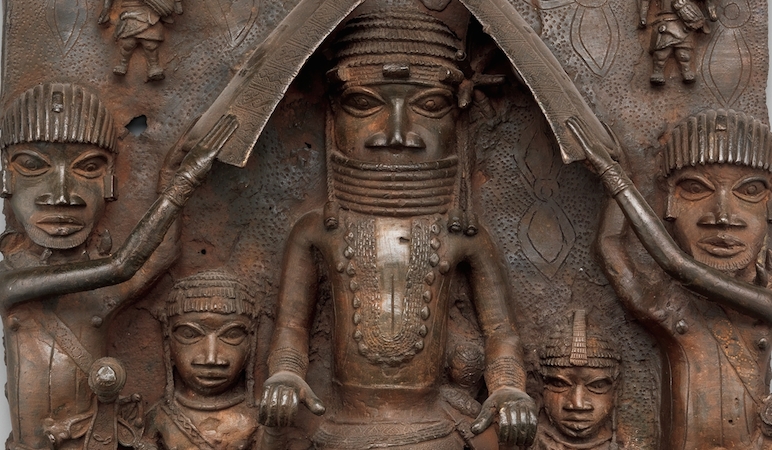
by Claude Lockhart Clark © March 10, 2016
Edo bronze castings and Ivory carvings rank with the best of global antiquity. Many cultures in European and Asian antiquity produced excellent bronze casts, but Edo City produced the best metallurgist capable of casting with fewer flaws or flashes. The finished sculptures during the early years were lightweight and had a uniform thickness. Both Europe and America used African metallurgist to help them solve difficult problems concerning metal casting. An African slave cast the lady on top of the nation’s capitol building in the U.S. The art of Edo Ivory carving is rivaled by no other ivory carving produced elsewhere. 

We use the term bronze for all high quality metal casting performed using any copper alloy, but in actuality non-of the Edo cast used bronze at all. Bronze is a tin copper alloy. The Edo metal casts are brass alloys with some containing traces of iron deposits. 

West African skilled metal artisans first worked iron before the appearance of brass alloy, which they obtained through trade. Once African artists identified brass as a meltable metal. They began to experiment with casting pretty things; pretty objects. Iron was still more important because it was practical and you could make it useful in farming, hunting, making weapons and carving wood. Brass was too fragile to use in manual labor. Iron also had both medical and magical properties which brass didn’t which may explain brass casts had iron deposits in them. Once iron was combined with brass the African copper alloyed had stronger properties than other copper alloys used elsewhere in the world. Once the brass alloyed was combined with iron it became more practical spiritually. 
Metal casting, ownership of ivory carvings and wearing coral necklace jewelry were arts reserved for the Oba in Edo city. Once inside the city walls the Oba-s artisan didn’t go outside his palace walls. The city walls of Edo had a dual purpose. First they served as a defense to deter enemies outside and second the walls served as a prison for servants and slaves of the king to keep them inside the palace walls. The Edo craftsmen produced stylized realistic human figures and heads along with abstract designs. Craftsmen made sculptures depicting animals as well. The art guilds were inside the king’s palace and if people working for him were male; they were all eunuques to make sure that the future heir to the throne was an offspring of the Oba.
The most impressive thing about Edo bronzes is their “uniformity thickness” or should we say “uniformity thinness” of cast brass sculptures from antiquity? The rest of the world would not champion their records until the nineteenth and twentieth centuries. Another interesting feat in casting was that there was iron added to the brass. Both Edo and Ife did “bironass casting” or iron-brass alloyed. African metallurgist added just enough iron to the brass alloyed in order to raise the temperature slightly higher than temperatures normally used in brass casting which helped the brass to flow more smoothly. We don’t know if bironass casting was a policy in Edo and Ife, but the sculptures tested thus far have iron deposits. 
The plaques were [are] generally about 1/8 inch thick (source is from wikipedea). Some of the early brass heads done in Edo are much larger and yet weigh slightly less than the classical heads done in Ife. The walls of some of the Edo heads are thinner and the iron content of the Edo casts appears to be higher.
BENIN BRONZE CASTING TECHNIQUE
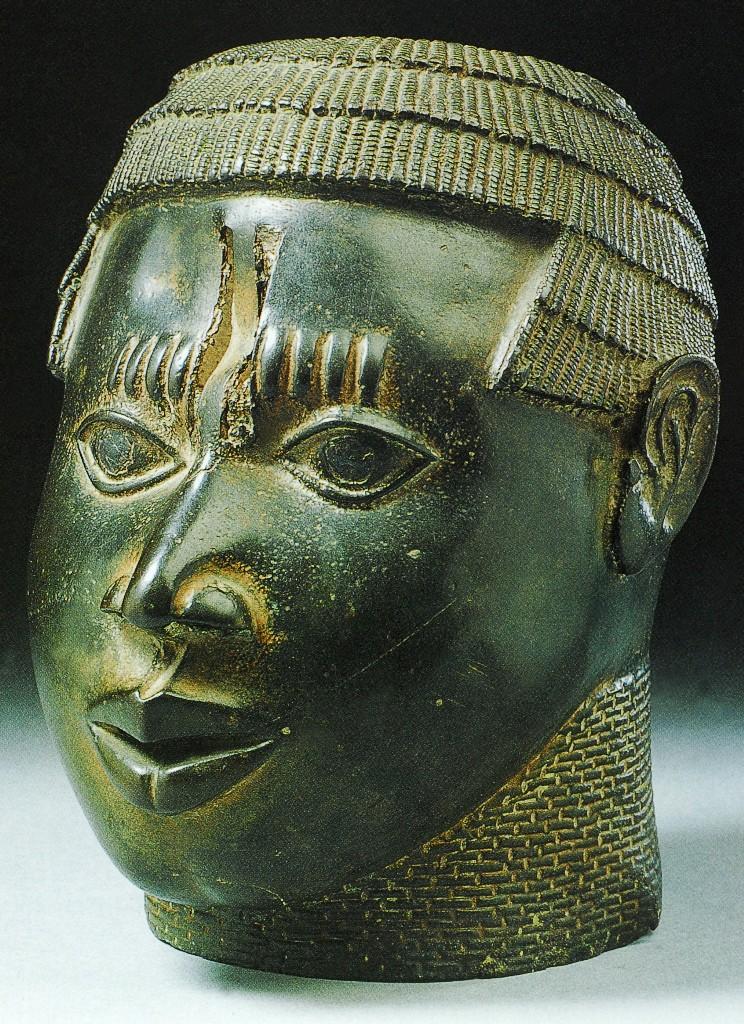 | Tweets by ClaudeLClark |
|---|
The objective of Edo bronze casting is to keep both the hollow sculpture chamber and metal laden chamber the same temperature so that during the transfer of metal from one chamber to the next the process will flow as smooth as possible.
Edo metal casting is a double chamber kiln driven process and not crucible, mold, furnace; kiln casting process. "Crucible casting" is a "cold cast". "Chamber casting" is a slow "even temperature process". Both chambers maintain almost the same temperature during the transfer of molten metal from one chamber to the next. 
Crucible casting consists of trying to "blast the living hell out of metal using a furnace". The mold is then removed from a kiln which is cooler than the molten metal. Then metal is poured into a "Luke warm mold before it turns to ice".
At the British museum in England it has been discovered that the metal content in Ife heads and Edo bronzes are derived from brass rods transported by camel caravans from Western Asia across the Sahara desert to West Africa. This would partly explain the smaller head size of human portraits in Ife bronzes and small bronze plaques of Benin. It should be noted that Benin had the record for thin brass casing of any civilization in ancient antiquity, but before we pump our chests and crow loudly this choice may be due to scarcity of metal rather than any esthetic considerations. In later periods Benin imported brass from Europe in larger quantities making it possible to cast thicker and heavier bronzes which was a measure of the Oba’s wealth something which would not have been possible in the past. 
Materials used in Edo casting were cheap and simple. The material used for clay modeling was a mixture of clay and charcoal and the wax used in modeling was bee’s wax. The metal used for casting was of brass; a mixture of copper zinc lead and iron added. The charcoal was wedged (a kneading process) into the clay. Some clay portions were kneaded with broken pieces of potash pottery to produce grog. The clays were put into separate unites to be used where needed in constructing the sculpture and chamber process. Beeswax collected from wild honey hives was used separate from the clay. It was used to sculpt the middle section of the sculpture chamber. Wax was modeled over the clay core of the first sculpture then a then layer of charcoal clay slip (a form of liquid clay consistency) was put over the wax. 

In the past, there was never any “mold crucible casting” done in Edo. In Edo the brass casters perfected a “two-chamber method of casting” metals; “double-chamber casting”. The first chamber was a “sculpture chamber” modeled separately in clay first; then wax was modeled on top of clay. After that more clay was added on top of the wax surface. After that the sculpture chamber was completed using more clay; a heavy consistency clay mixed with fine pottery potash was added. The sculpture chamber was placed upside down in a kiln and only the wax portion of the sculpture was melted out, causing a cavity where the wax sculpture once was leaving the clay sculpture still intact. Next the clay chamber laden with metal (a “casting chamber”) was attached to the “sculpture chamber” forming an “hour glass”. The double chamber was placed inside a furnace to begin a process known as “gravity casting”. One procedure would be, heat the double chamber with the metal chamber at the top then leave it until all of the metal inside had flowed into the sculpture chamber located at the bottom. There was another procedure used. They would put the clay chamber with the metal at the bottom of the furnace, facing up, then flip the double chamber upside after the metal in the lower chamber liquefied. This allowed the molten metal in the upper chamber to flow into the cavity left by the wax in the lower chamber.
You are going to have trouble finding material on Edo culture when using search engines so us the word Benin. That makes it a little easier but the country Dahomey has been changed to Benin and the people there have sculptures as well. Don’t get discouraged. When you get finished with your studies of traditional African art at Earth Metropolis website you will be a professional at it. 
Now here are just a few of the problems you will have with the word Edo. Edo is the name of a city in Nigeria. Edo stands for Executive District Officer in Pakistan. Japan has a city bearing the name Edo. The Japanese and African Edo were centers of commerce and became capitol cities, but there is no relationship what so ever. The name Edo in Japan has been changed to Tokyo, but they still use the word Edo when they talk about culture in a particular geographical area and when they talk about the history of Tokyo.
The people living in Edo Nigeria call themselves Ovbiedo (children of Edo). The Portuguese Called the Ovbiedo People Bini and their capitol city Benin City. The people of Benin City Nigeria called themselves Ovbiedo people and the name of their royal city Edo City.
The Ovbiedo have had a royal family for a long time, but today’s lineage stems from Oduduwa an ancestor of the Yoruba kingship in “Old Oyo”. The Yoruba kingship began in Edo about 13th or 14th century. The bronze casting started in Edo about 15th century. Bronze casters were sent from Ife to reveal the secrets of lost wax casting in bronze to the Ovbiedo. The Oyo Yoruba-s originally came in a series of waves from Egypt to Benue River region starting around 600 AD. It is believed that they were Coptic Christians, but they used and modified the deities of the aboriginal people living there and introduced the concept of “Ifa” (deity or house of wisdom) and the priest that performs the oracles and recites the verses is a babalawo (father of mysteries). This unifying concept is absent in most West and Central African religions. 
The culture and customs of aboriginal people living in Edo are different so the religious practices in Edo are different as well. 

The Ovbiedo royal family has biological links with the Yoruba-s in Old Oyo City. The biological link was through Male lineage, but the Edo recognizes the female lineage, not the male. This is where the lineage of Oduduwa makes its departure at Oyo; it virtually no longer exist in Edo. Every Oba that comes to crown has no direct male lineage to Oduduwa. His link to Oduduwa meanders through maze of male and female links. The Oyo-s and Yoruba-s are patrilineal and the Edo people are matrilineal. The Oba lineage in Edo may be older than Oduduwa kingship among the Yoruba. The Oba appointment in Edo City is partly determined by the Queen mother appointment and the queen mother lineage’s date earlier than the arrival of the first Yoruba king in Edo.
The art of Ife City bronze casting was introduced into Edo City by the Oyo-s during the 15th Century AD. 
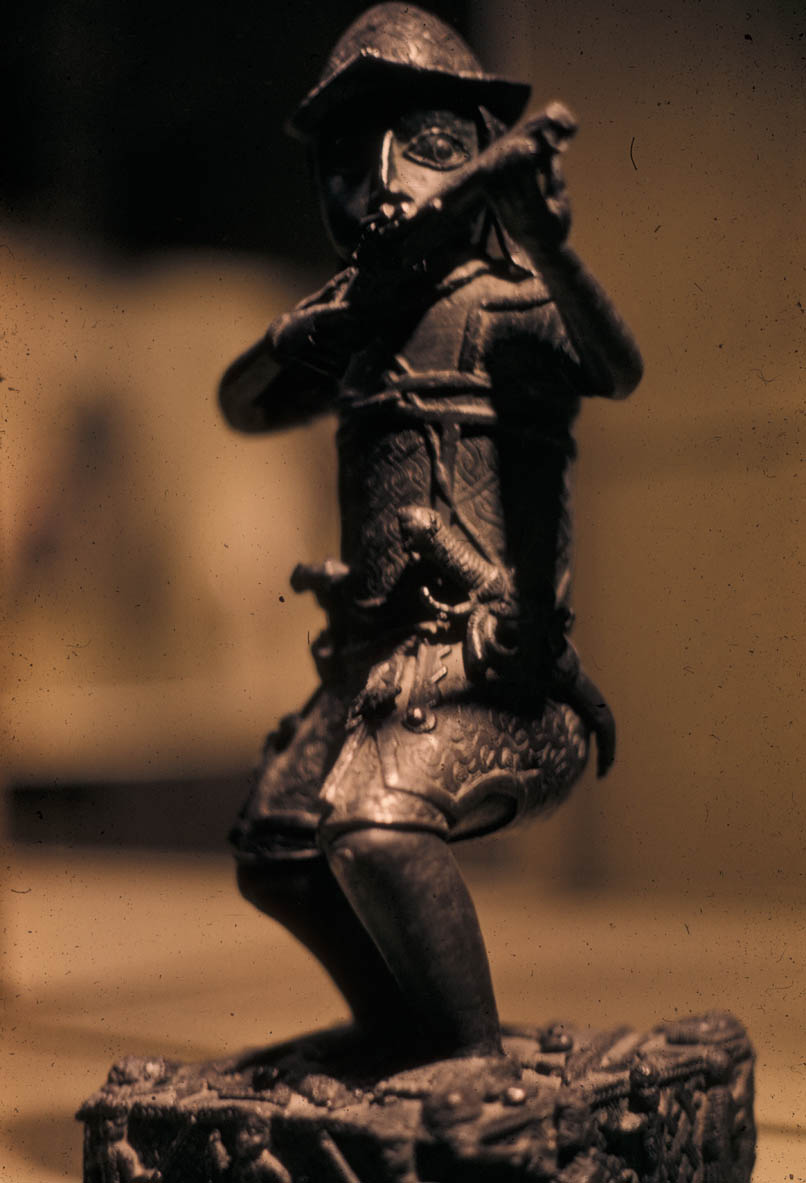 | 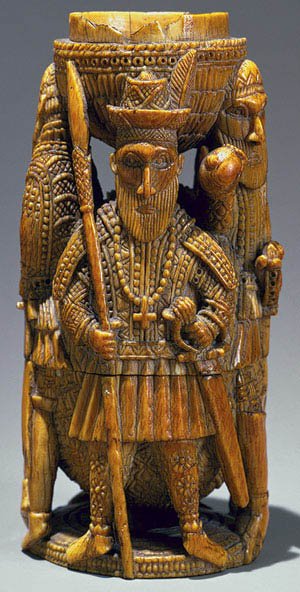 |
|---|
by Claude Lockhart Clark © March 10, 2016
These two images depict two very different views of Portuguese done by two Edo artists. The bronze image is an Edo concept of what a Portuguese Soldier look like to an Edo (Bini) craftsman. The image of the Portuguese Soldier is viewed from an African world, not a hybrid world. Western Civilization is a Hybrid Civilization it grew out of Europe’s association with it’s over seas colonies. This image of a Portuguese Soldier is not Western Art. It is African art even though a European is subject in the sculpture. The ivory sculpture is not European Art though it reflects many of its values and at the same time it is only partly African. Therefore the ivory sculpture is a hybrid mixture of two worlds and must be considered Western Art. 

The following passages are a European or Western Description of the Ivory sculpture above on the right.
Saltcellar: Portuguese Figures, 15th–16th century Nigeria; Edo peoples, court of Benin Ivory
ON VIEW: GALLERY 352 Last Updated July 27, 2012 H. (a & b) 7 1/2 in. (19.1 cm) Louis V. Bell and Rogers Funds, 1972 (1972.63a,b) 
"This saltcellar created by a Benin ivory carver reflects a local interest and emphasis on extensive detailing of dress and regalia found in other forms of Benin court art. Articulated in exacting detail, four Portuguese male figures, two richly adorned men and their attendants are depicted around the perimeter of the receptacle. The higher status figures are depicted frontally, facing outward. The attendants are in profile, more crudely rendered, and in motion.
The two wealthier men are laden with the trappings of their status. This includes the patterned high-crowned hat with a feather decorating its brim, the knee britches, a buttoned doublet with flaring shoulders and sleeves and bodice, keys, crosses, swords, and spears. Two-dimensional fabric patterns are translated into low relief, endowing the work's surface with an intricately arranged series of textures. This baroque layering of forms nearly disguises the structure of the object
This particular saltcellar is one of four of almost identical design; the others are currently in European collections. This is the only one that has survived primarily intact. It is believed that the four were intended as a set, perhaps as a gift for a patron's table". © Latrice logika Gedink Posted August 14, 2012
IVORY HOLOCAUST “WHITE AND BLACK CARNAGE”
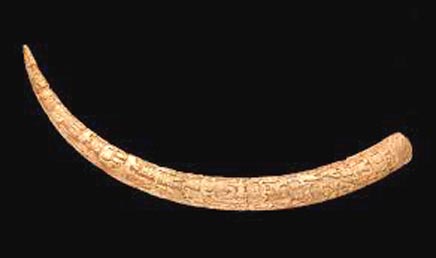 | 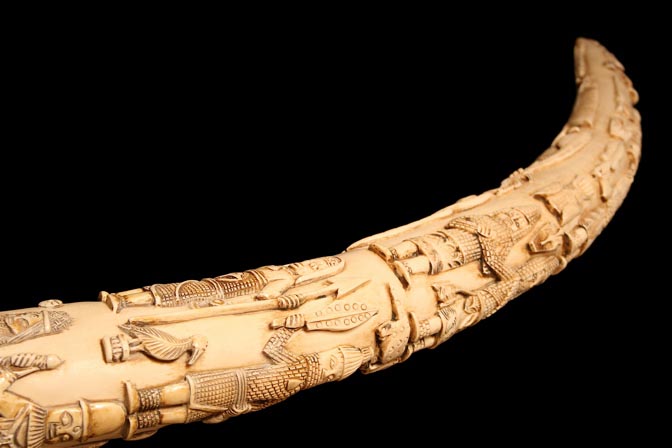 |
|---|---|
| Carved Ivory Signaled Something Else Was for Sale | This Detail is Proof of Highly Skilled Human Resource |
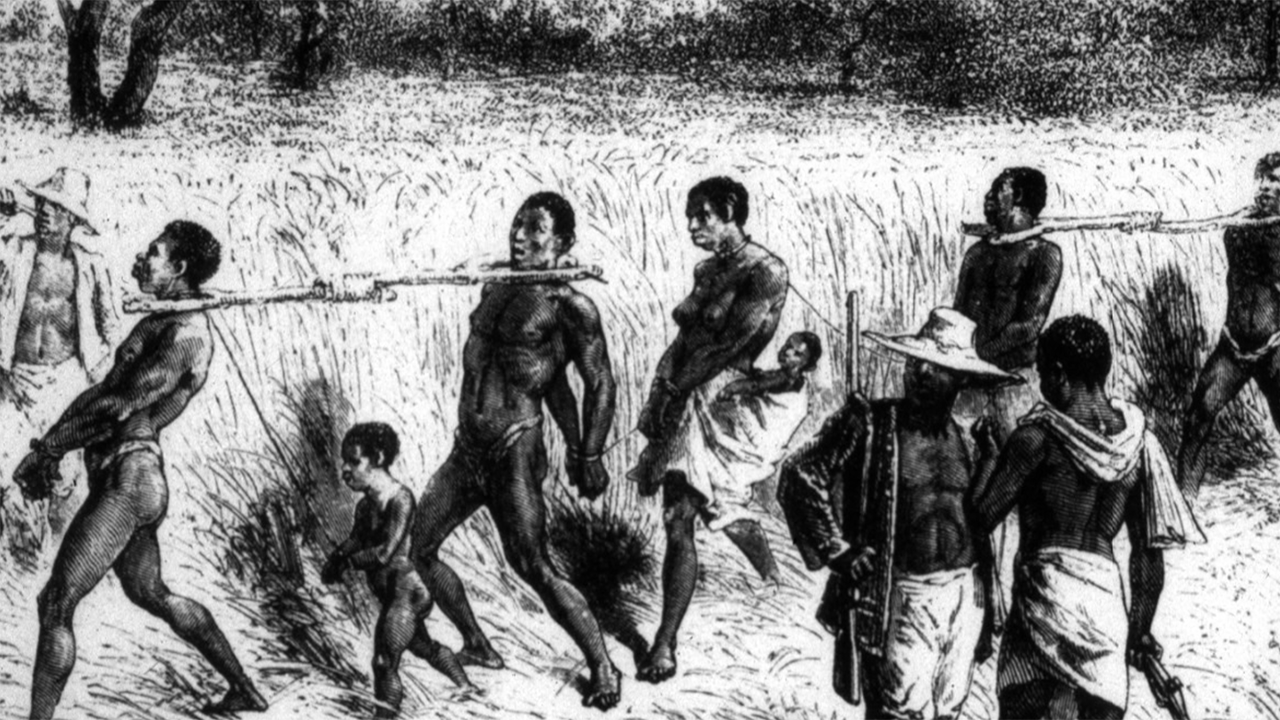 | 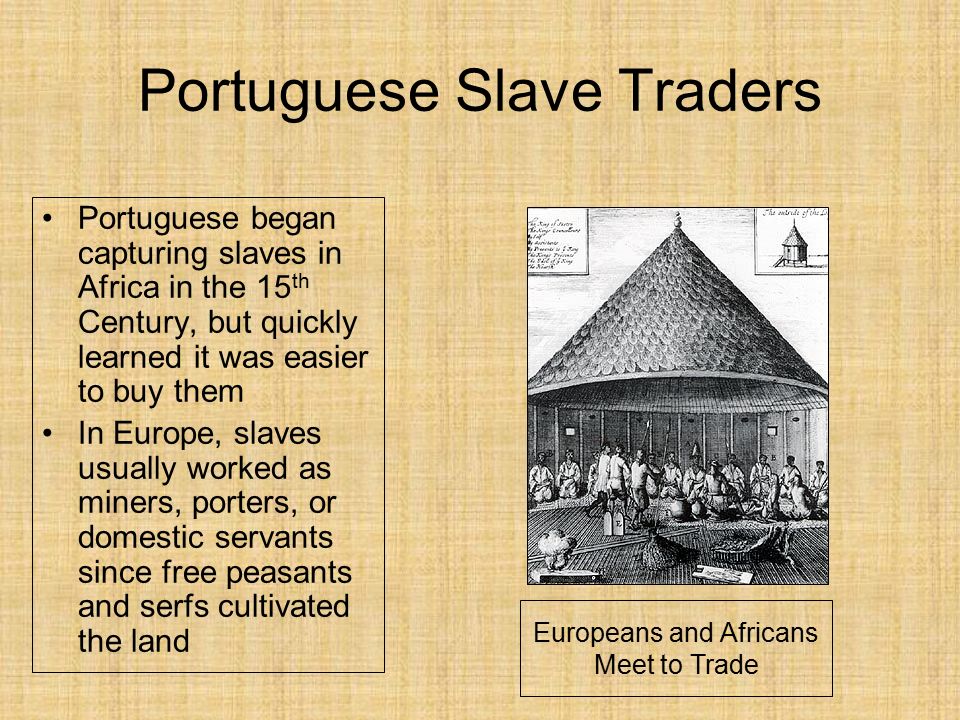 |
| Africans Were Herded & Exported Like Human Livestock | Others Were Sent Here Because of Their Skills |
 | 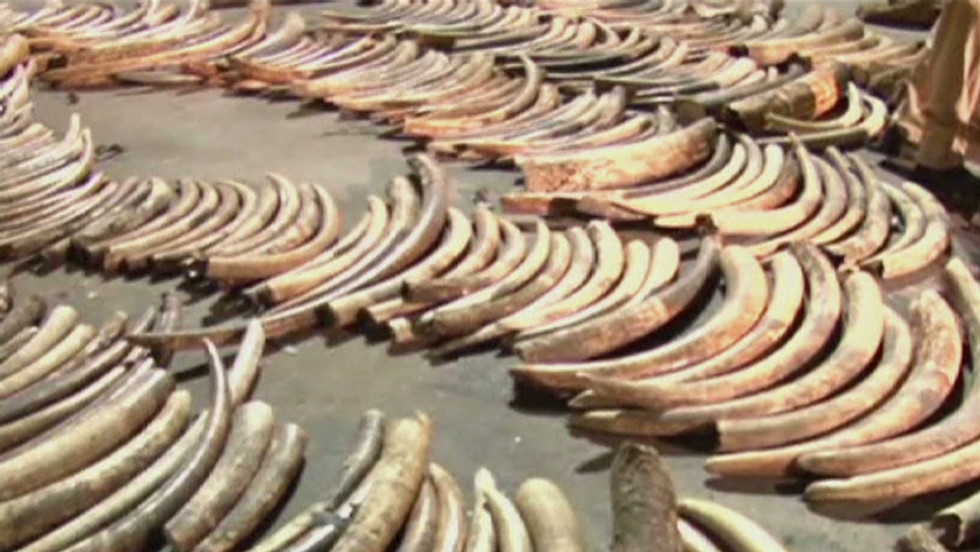 |
| Imperialist & Poacher Went Loco Balucky over Elephants | Imperialist & Poacher Went Loco Balucky over Ivory |
DUMB MOVES, “DUMB CHOICES; DUMB EXCUSES - WHERE DOES IT END?”
The Portuguese only wanted ivory tusks but in the course of sales they came across carved tusks. This gave enterprising bankers and businessmen other ideas. They could purchase highly skilled slaves to work for them, for free making only things suited for European culture rather than African or both. 
MALLENCE BART-WILLIAMS SAYS "SHARITY, NOT CHARITY"
Foreigners never buy anything from Africans. All they want from Africa is good “pussy” in the form of mineral resources, plants and animals. They will cut down all trees; steal herbs from the forest to make drugs. Foreigners take our land to make space to grow cash crops that they want for themselves and when it comes to pricing we have no choice in the matter.
The Moroccans make and sell leather goods, rugs (second only to Persian rugs), silver jewelry (that is where Spanish and Native American jewelry come from), textiles; architecture and interior furnishings. Moroccans sell to Southern European markets in Europe. Moroccans live in Africa; they Black; so don’t tell me you can’t. I know what you thinking. Moroccans are in close proximity to Europe and can swim the Mediterranean Sea any time they want. What you need is a good ass whipping and this mess would clear up in no time. 
You have one alibi; one excuse left. The Moors dominate Europe for four hundred years and saturated it with Moorish culture. I don’t care. Proximity and dominance ain’t got nothing to do with it. It is painstakingly stalking your adversary’s marketplace and perseverance that counts. The Moors are still Black, so bend over and get your ass whipping.
Black people in America created Jazz and it is said to be America’s music, but we don’t have any stake in the political economic and direction of our own art form. There are no African American institutions to nurture; direct our culture and art. Jazz is their music, their market place, their business and not ours. Jazz principles in music dominate the world, but African Americans have no economic, political ownership of their craft. We owe it to ourselves and “the ones yet to come” to change that.
We caste Benin bronzes and the British had to steal and scrutinize them until they finally realized they were worth something. Benin bronzes rate high on the stock exchange. You can borrow and loan currency notes against them the same as you would gold and silver. 
We want our art back at any cost. Our self worth and self-esteem are at stake. Europe and other Western countries have an abundance of art treasures to show to the world and we don’t. Right now most of those treasures belong to someone else. Several African countries are about to embark on an outer-space mission with Europe and the United States of record borrowing, lending and spending spree proportions which will send African art stock prices souring through the earth’s stratosphere, but Africans won’t receive a penny of that money. Europeans and Americans will still own the art. Some of the basic necessities concerning the human population will go unmet because their politicians will be fooling with the art. © Claude Lockhart Clark Oct. 16, 2019
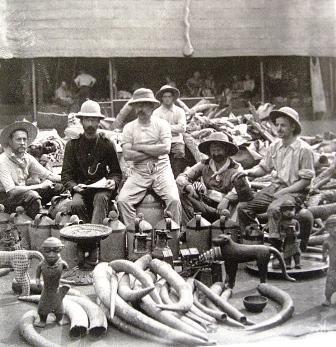
British Theft of Indigenous Wealth Culture & Autonomy
The following is an account of the theft and pillage of Benin treasures. At the end of the end there is a Wikipedia Encyclopedia link so that you can get a full account of the article. 
The "Benin Massacre" In November Phillips made a formal request to his superiors in England for permission to invade Benin City and in late December 1896, without waiting for a reply or approval from London, Phillips embarked on a military expedition with two Niger Coast Protectorate Force officers, a medical officer, two trading agents, 250 African soldiers masquerading in part as porters and in part as a drum and pipe band.[1] To disguise their intent, the force hid its weapons in the baggage carried by the 'porters'. His request to London was to depose the king of Benin City, replace him with a Native Council and pay for the invasion with the 'ivory' he hoped to find in the king's palace.[1] In the meantime he sent a message forward to the Oba, Benin's king, that his present mission was to discuss trade and peace and demanding admission to the territory in defiance of Benin law explicitly forbidding his entry. Unfortunately for Phillips, some Itsekiri trading chiefs sent a message to the Benin king that 'the white man is bringing war'. On receiving the news the Benin king quickly summoned the city's high-ranking nobles for an emergency meeting and during the discussions the Iyase, the commander in chief of the Benin Army argued that the British were planning a surprise attack and must be defeated. The Benin king however argued that the British should be allowed to enter the city so that it can be ascertained whether or not the visit was a friendly one. The Iyase ignored the king's views, and ordered the formation of a strike force that was commanded by the Ologbosere, a senior army commander, which was sent to Ughoton to destroy the invaders. 
STOLEN BENIN HERITAGE INSIDE THE BRITISH MUSEUM
On 4 January 1897, the Benin strike force composed mainly of border guards and servants of some chiefs caught Phillips' column totally unprepared at Ugbine village near Ughoton. Since Phillips was not expecting any opposition and was unaware that his operation was being perceived with alarm in Benin, the contingent's only weapons, consisting of the officers' pistols, were locked up in the head packs of the African porters.[8] Only two British officers survived the annihilation of Phillips' expedition,[9] which became known as the Benin Massacre'.
The Benin Expedition of 1897 was a punitive expedition by a United Kingdom force of 1,200 under Admiral Sir Harry Rawson in response to the ambush of a previous British-led party under Acting Consul General James Philips (which had left all but two men dead).[1] Rawson's troops captured, burned and looted Benin City, bringing to an end the west African Kingdom of Benin. Much of the country's art, including the Benin Bronzes, was looted and taken to Britain. © Wikipedia, the free encyclopedia
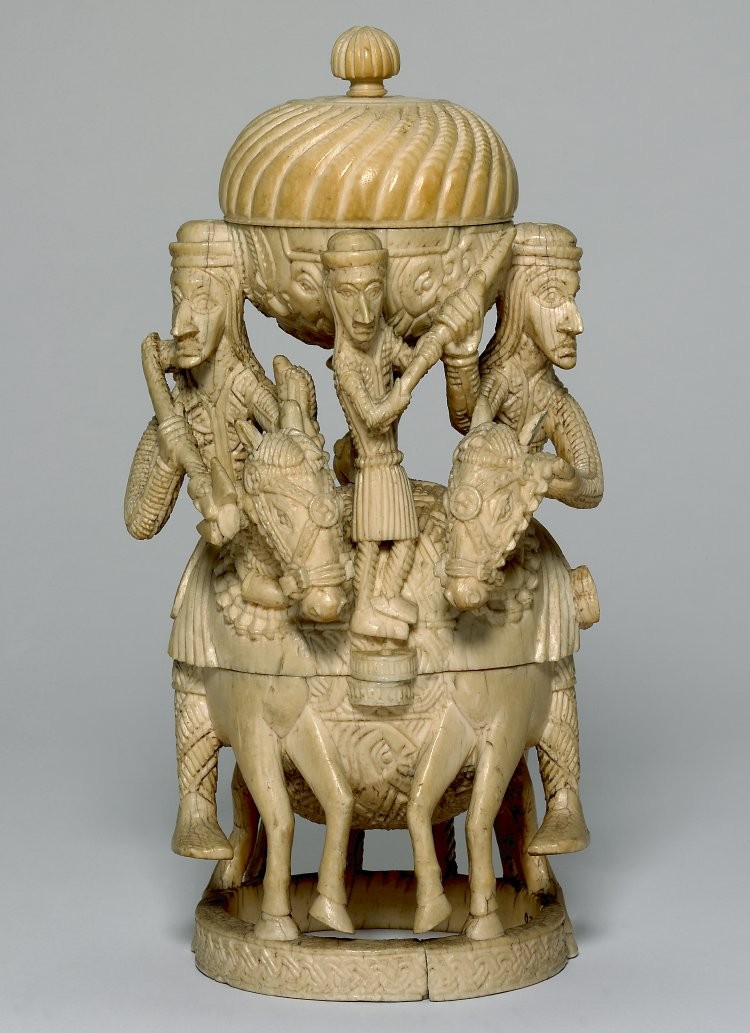 |  | 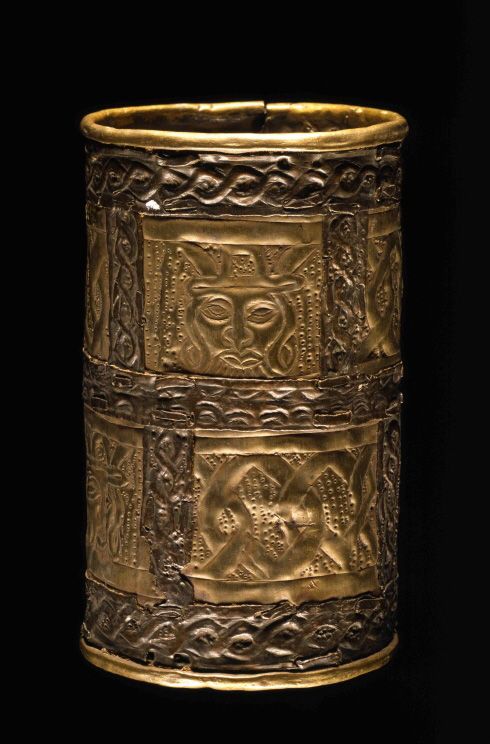 | 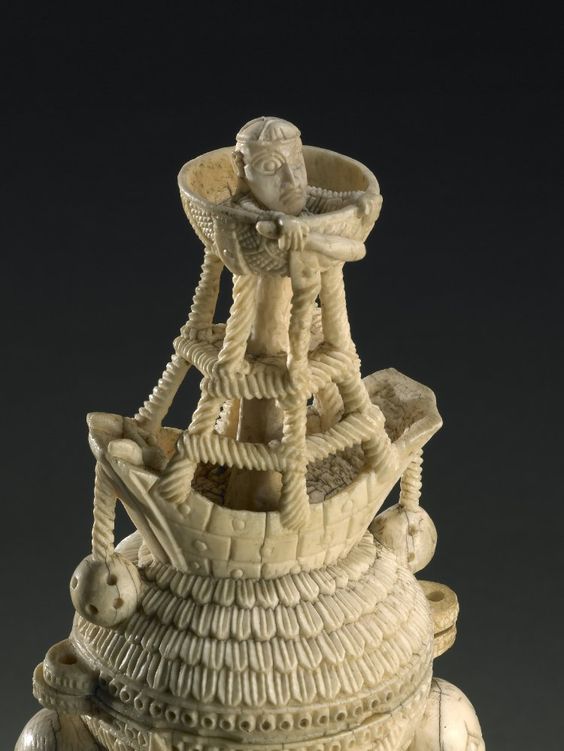 |
|---|---|---|---|
| Benin Ivory Salt-Cellar With Lid | Benin Ivory Salt-Cellar | Benin Gilt Brass Bracelet | Benin Salt-Cellar Top |
African Ivory had always been sought after by European since about 9,000 to 10,00 A.D.; Western Asians and the Far East; in particular China went after the ivory beginning with antiquity. The elephants in East Africa were the best. Europe had a problem with Ottoman Turks and North African traders., In the 14,000 were Portuguese explorers were searching for a rout to the Far East and an access to East African Elephants. They soon found out that Africans living along the Guinea Coast and Congo River had access to ivory. Their best prospects were located in Edo in the heart of “Bite of Benin”. The coastal area was infested with tsetse flies and malaria-ridden mosquitoes. On Sherbro Island of the coast of what is now known as Sierra Leon or Mountain of Lions had ivory carvers in service to the Portuguese. The Africans there mixed African imagery freely with European imagery in their work and they seemed to enjoy what they were doing. Portuguese then were able to establish a City Colony of Loango on the coast of Central Africa. The artists did not seem to understand fully Western culture thou they were exposed to it constantly. Additional can be found at —— Metropolitan Museum of Art website dot org. In Edo there was no soft landing off the coast of Bite of Benin and Europeans were not particularly wanted in Edo; so Portuguese were able get The Oba (king) to sell them ivory carvers from Edo. If you examine the Western product produced by African ivory carvers from Edo you will notice that the artists are more familiar with European item in their work and they showed strong evidence of mincing looks and a lack of trust in the faces depicting their adversaries. There was less opportunity to do things that depicted Edo culture mixed with European culture. BENIN IVORY CARVING TECHNIQUE
One of the methods in carving ivory was a burial method. The ivory tusk was buried in wet earth. Note: you have the grain in the Ivory and maintaining the white color of ivory to be concerned about if you use that method, so I do not know what clay or earth types they used. The tusk or ivory sculpture was buried in the wet ground to soften the grain or fibers; then it was dug up from the ground to carve, then put back in the ground again. The artisan could carve the ivory for a few hours at a time before having to place it in the ground again to soften the fibers once more. BENIN WOODCARVING TECHNIQUE
African woodcarving begins with an adze, axe or a machete. Principle is always the same. The artist connects with the wood by either striking, or slicing it. Africans use the machete the same way Chinese use a cleaver; slice the wood. The axe and adze are used in the same fashion that one would use a digging stick. You strike the wood with an adze, axe; never chop it. Carving with a machete, Axe or an adze is always carving and shaping process; never a roughing out process. The wooden object being carved is always smooth. A knife or rough leaf used for sandpaper is used to apply a finer polish. Starting in the 1400s Europeans saw the world as having two distinct economic divisions, one consisting of “purchase and selling” goods and services and the other one consisting of "bartering" for goods and services. Europeans chose not to recognize bartering economic systems. They used Venetian and Dutch beads as monitory units. The number of units contained in each type of bead, each strand of beads and each bunch of strands was set. Those units never changed. You could only inflate or deflate the beads, but the number units never change. Those units applied to each bead type always stayed the same. Africans never understood that concept. They understood units and numbers very well, but they did not understand the coin. Be sure to read my essay titled “Coin Conspiracy”. The Dutch brought cowries by the shipload and literally dumped them on the shores of West and Central African coasts so that cowrie would be worthless in trade or monetary exchange. Above are items produced by Ovbiedo People applied to a different culture and different Civilization. Continue to read. Then click on the items to obtain further information about each product. Traditional African Art was interrupted by the dawn of Western Civilization. Western Civilization began in Africa. Portuguese explores were searching for African slaves, gold and a rout to India and China. In the course of their journey they discovered ivory along the “Guinea Coast” and “Slave River in the Bite of Benin”. The journey and origins of Western Civilization begin with ivory. Among the ivory cargo imported were tusks decorated with carved images. These images gave a young venture capitalist and banker named Bartolomeo Marchionni a splendid idea when importing slaves. Why not request skilled ivory craftsmen from African traders and kings to be included with the rest of the human livestock? Between 1480 and 1495 the first examples of Western Art were produced in one of Marchionni’s human sweatshops. Western Art did not start in Edo. It began either on an island off the coast of Sierra Leon or off the coast of Democratic Republic of the Congo. The “Bite of Benin” prevented Portugal from doing business with the city of Edo until the 1490’s. The tsetse fly lived there in the river deltas and coastal regions where the bites occurred. The fly is known for its thirsty blood diet. It also transmits a particular kind of kinetoplastid protozoans parasite into humans causing sleeping sickness and Nagana in other animals. Europeans had no immunity to the parasite. Another problem preventing Europeans from reaching Edo City where the Africans collecting tolls and acting as agents for kingdoms in the interior. And a third was a defense capability that the Edo Kingdom had that no other African Kingdom had during the Fifteenth through Seventeenth Century. The first barrier Europeans could learn to evade or get around the fly. The remaining two barriers slavery would take care of. Once Europeans realized that the Ovbiedo would sell their own people taking over Edo City and the Ovbiedo people would be a slam-dunk. They turned the Oba into a “Charlie Finley”. For those of you who don’t know who Charlie Finley was; he was a baseball team owner in California who bought and sold baseball players as though he was buying and sell livestock. That kind of behavior ruins an athletic team and will eventual take its toll on a nation. For Edo it took a little over 300 years to bring Edo down on its knees. Portuguese used a policy that other Europeans adopted as well. They would only buy people that had skills, then made an inventory of labor skills their “cargo” contained before shipping “it” out of Africa. Using this tactic would collapse empires quicker and provide colonizers with the best labor. The first insight in to what kinds of skills Africans had for sale was with ivory. After Europeans found that they could buy Africa’s best labor they would not buy goods made in produced Africa. Europeans would only buy raw materials; after all once they could obtain the best human resources along with the best natural resource Europeans no longer needed to buy anything made in Africa. No other continent of people gave up their best commodities so easily. |
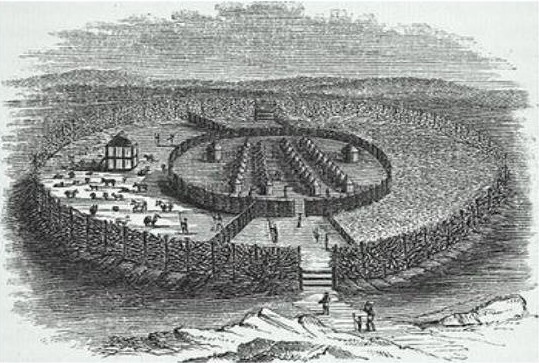 Edo Great Wall constructed between 800-mid-1400s AD | 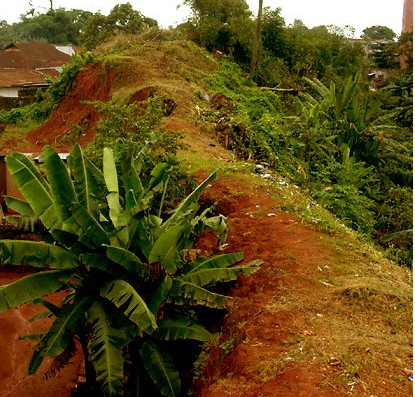 An inside wall surrounding a housing compound. |
|---|
Edo has been credited with having built the largest human structure ever built by humans. Edo has the largest moats ever built, some of which were filled with water. The name of the wall and moat system is "Igodomigodo". The Ovbiedo have the largest earth wall system in the world. The following is a quote taken from Nairaland Forum: 

“The Benin moat, also known traditionally as Iya, is the largest man-made earthworks in the world. It is larger than Sungbo's Eredo.[1] It enclosed 6,500 km² of community lands. Its length was over 16,000 km of earth boundaries. It was estimated that earliest construction began in the 13th century and continued into the mid-15th century. It predates the use of modern earth-moving equipment or technology in these parts. The moat encircles the old perimeter precincts of the City and was constructed as a defensive barrier in times of war. {5th} Oba Oguola {about 1280-1295} dug the first and second moats to fortify the City from invaders, including the Imperial European invaders, who at the time were hunting for African slaves labourers, Oba Oguola further decreed that important towns and Villages should build similar moats as defence systems around their communities.This gave rise to twenty of such moats around Benin and its environs. An extension of the moat was constructed in the 15th century during the reign of {12th} Oba Ewuare the Great (1440-1473 CE). The Benin moat is over 16,000 km kilometers long. The Walls of Benin City was the world's largest man-made earth structure.[2] Fred Pearce wrote in New Scientist”:
"They extend for some 16,000 kilometres in all, in a mosaic of more than 500 interconnected settlement boundaries. They cover 6,500 square kilometres and were all dug by the Edo people. In all, they are four times longer than the Great Wall of China, and consumed a hundred times more material than the Great Pyramid of Cheops. They took an estimated 150 million hours of digging to construct, and are perhaps the largest single archaeological phenomenon on the planet". 
The information above can be found at nairalandforum.com. There you will get a full description of size and measurements of each section of the Igodomigodo project and a full history of Igodomigodo. Keep in mind the city is Edo. The people are Ovbiedo and the physical portion of city plan is Igodomigodo. When you are talking about the wall, moat and water system defense infrastructure of Edo city you are talking about the Igodomigodo. 
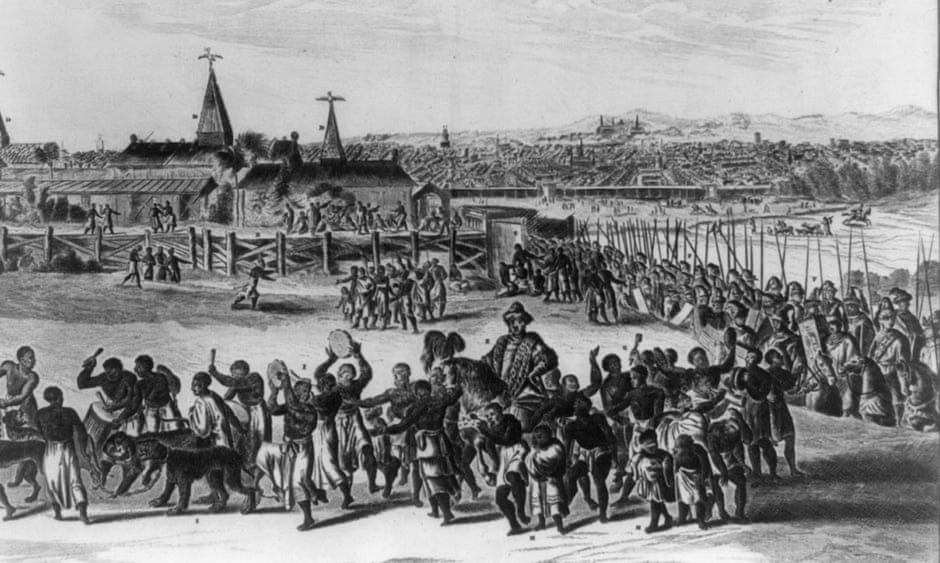
| Top |Benin Oba | Map | 16th Century Edo Western Art | Benin Court Art | Igodomigodo | Iner-city Maze Network |
| WHERE ARE THE TWO BENIN IN WEST AFRICA LOCATED? |
|---|
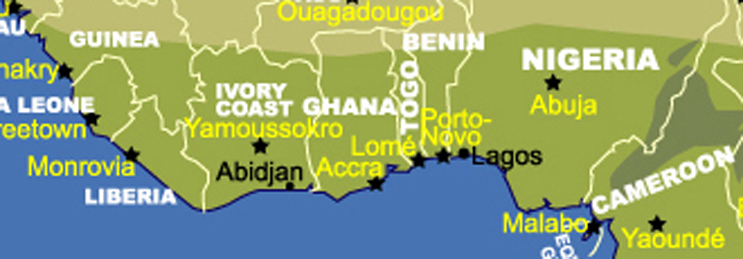 WESTERN SAVANNAH & DRY-RAINFOREST | 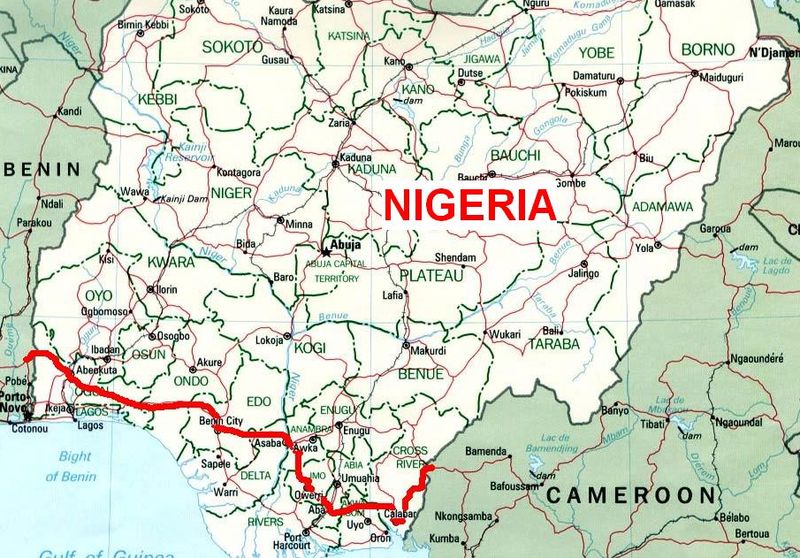 BENIN REPUBLIC IS GREEN & NIGERIA WHITE |
|---|
Edo crashed in 1897 never to rise again. Great Britain took over Edo in September of that year and placed the Oba in exile. Edo was taken down without fierce struggle. Edo was the cause of its own demise. The British did not conquer Edo City. Edo conquered itself. 
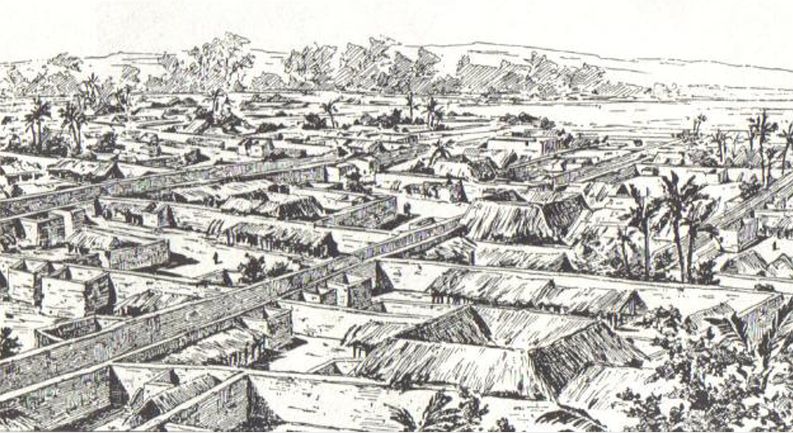
The “Inner-city Maze Network” is evident that families living inside Edo could defend themselves, “if they had wanted to”. Most fortifications are not set up so citizens can defend themselves. Most fortifications have to be garrisoned by troops to protect the civilians inside. Inside the Igodomigodo, both civilians and soldiers can take up the fight. 

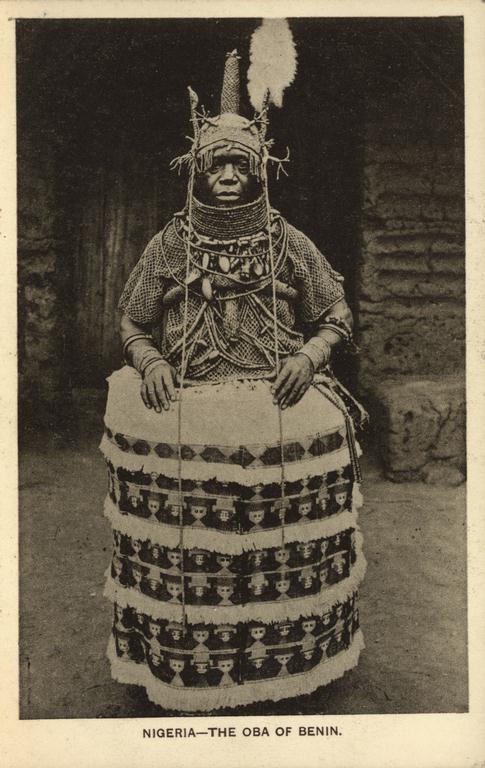
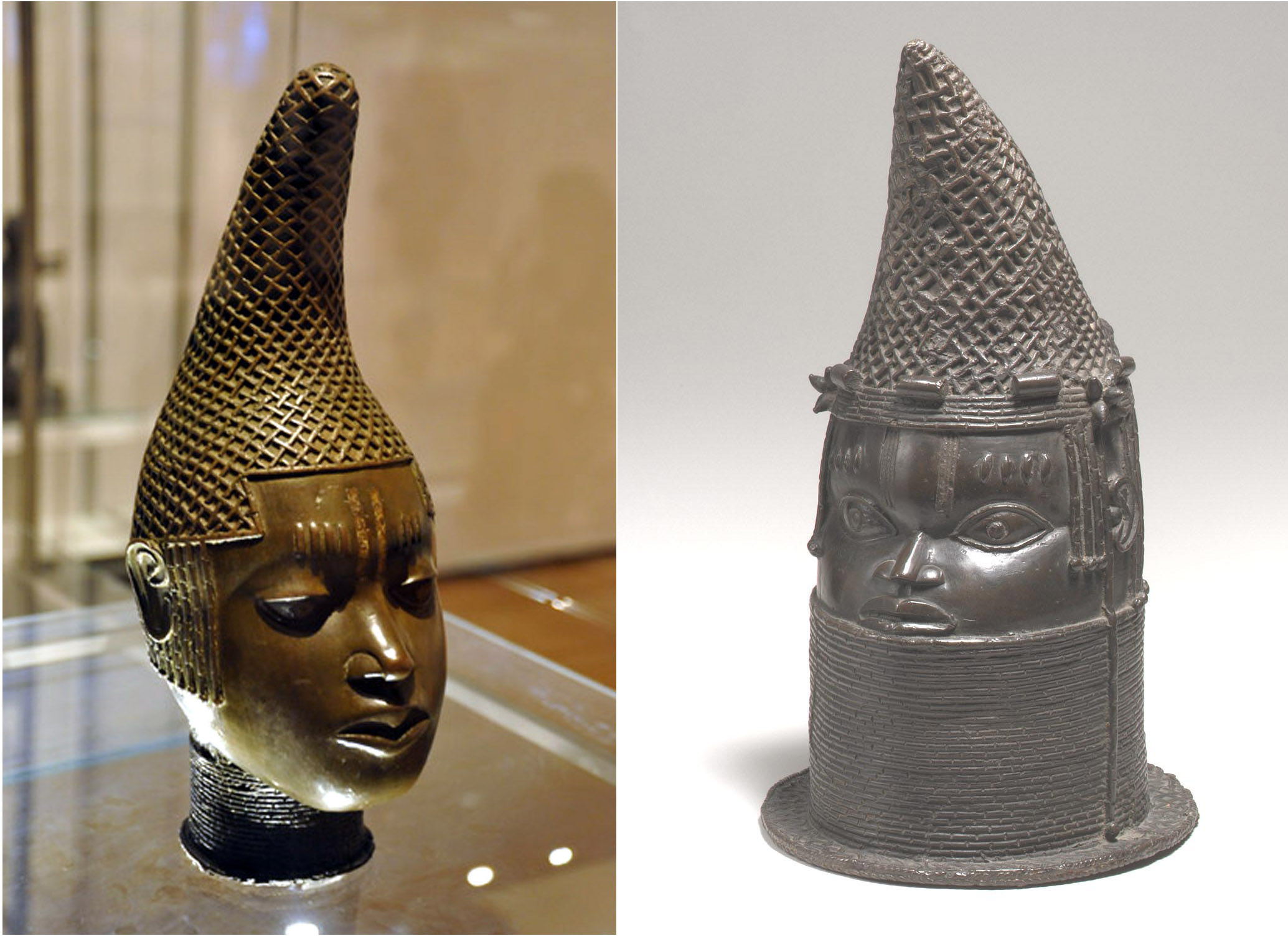
The Queen is advisor to the king. She is depicted with a phallic type horn looking crown on her head that bends forward. In the Classical Period there are coral beads strong close around her neck. In the late period the coral necklace bead become a high collar which reaches all the way up to her chin. 

QUEEN MOTHER IVORY BELT MASK PORTRAITS
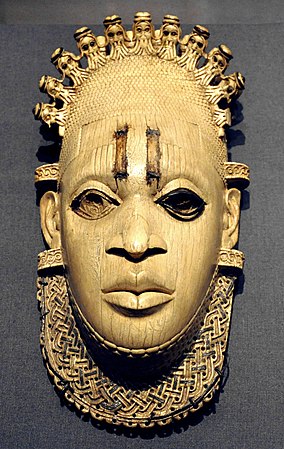 | 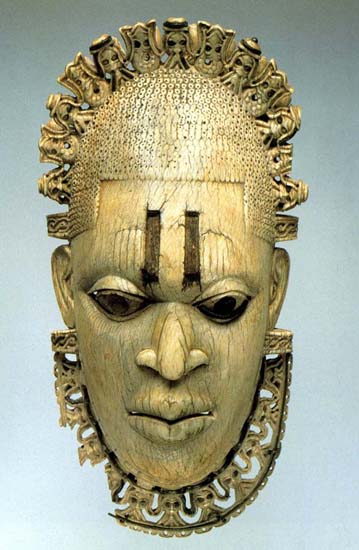 | 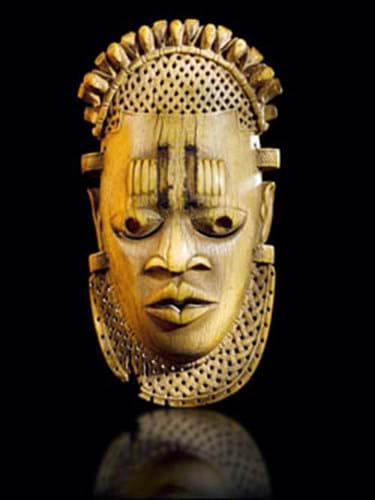 | 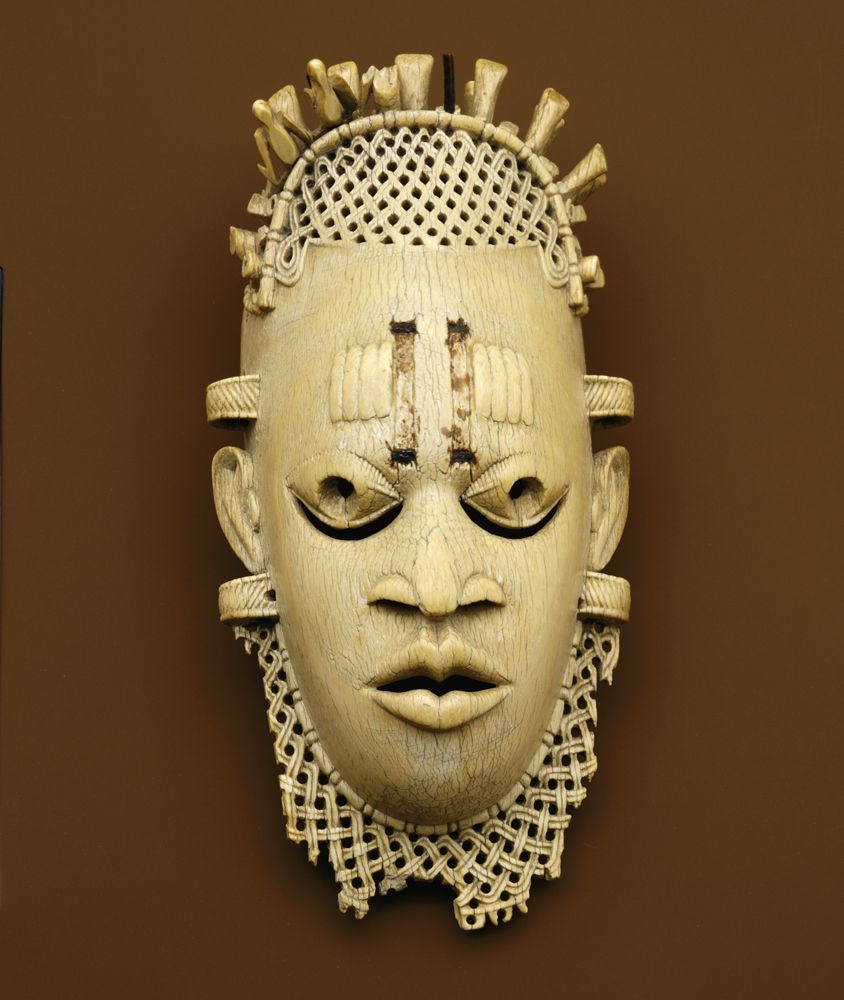 |
|---|---|---|---|
| Queen Mother Idia Ivory Mask | Benin Ivory Belt Portrait Mask | Benin Ivory Belt Portrait Mask | Benin Ivory Belt Portrait Mask |
Ivory masks above are portraits of Queen Mothers. They were worn with other ivory sculptures as ornaments around the Oba’s waist. 
The first mask starting from the left represents “Queen Idia. [She] was the mother of Esigie, the Oba of Benin who ruled from 1504 to 1550 [During the period of contact with the Portuguese]. She played a very significant role in the rise and reign of her son. She has been described as a great warrior who fought relentlessly before and during her son's reign as the Oba of the Edo people”. © Wikipedia
The second Edo ivory mask, moving from left right is located in the Metropolitan Museum of Art in New York City, New York. It was a gift from the Nelson Rockefeller Primitive Art Collection.
 | 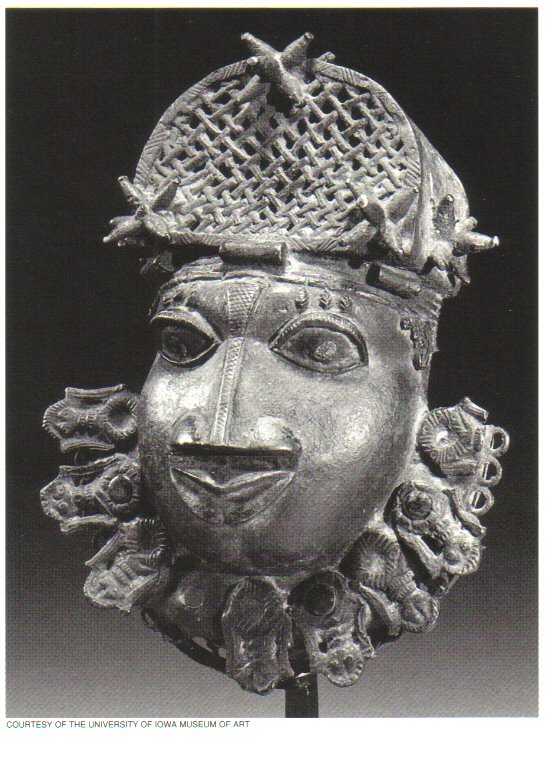 | 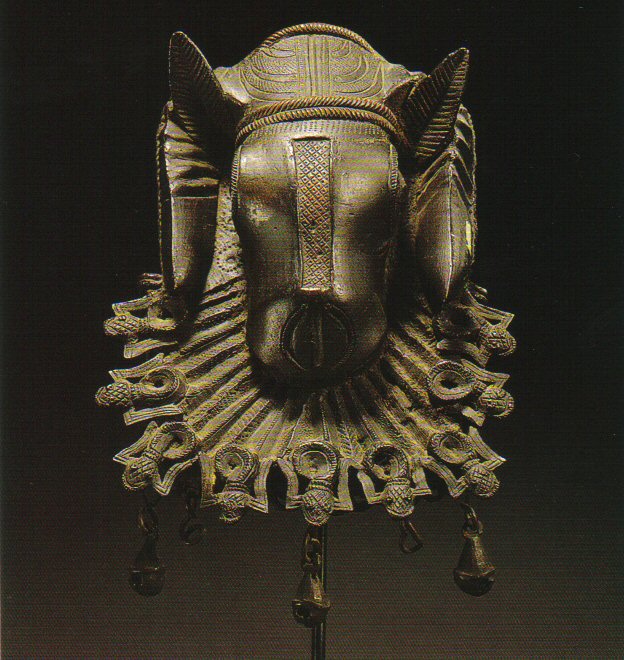 |  |
|---|---|---|---|
| Oba Mask(18th-19th cen. AD) | Benin Bronze Mask | Benin Hip Mask of Ram's Head | Benin Brass Leopard 18th cen |
The masks shown here were only wore on the Oba's belt and should not be confused with other types of Benin masks. The oba wore brass mask on a waist belt along with Ivory masks. Most brass masks were simple, but some were very detailed and complex like the ivory masks. The masks depict both animal and humans. 
BENIN OBA IVORY BELL SELECTION
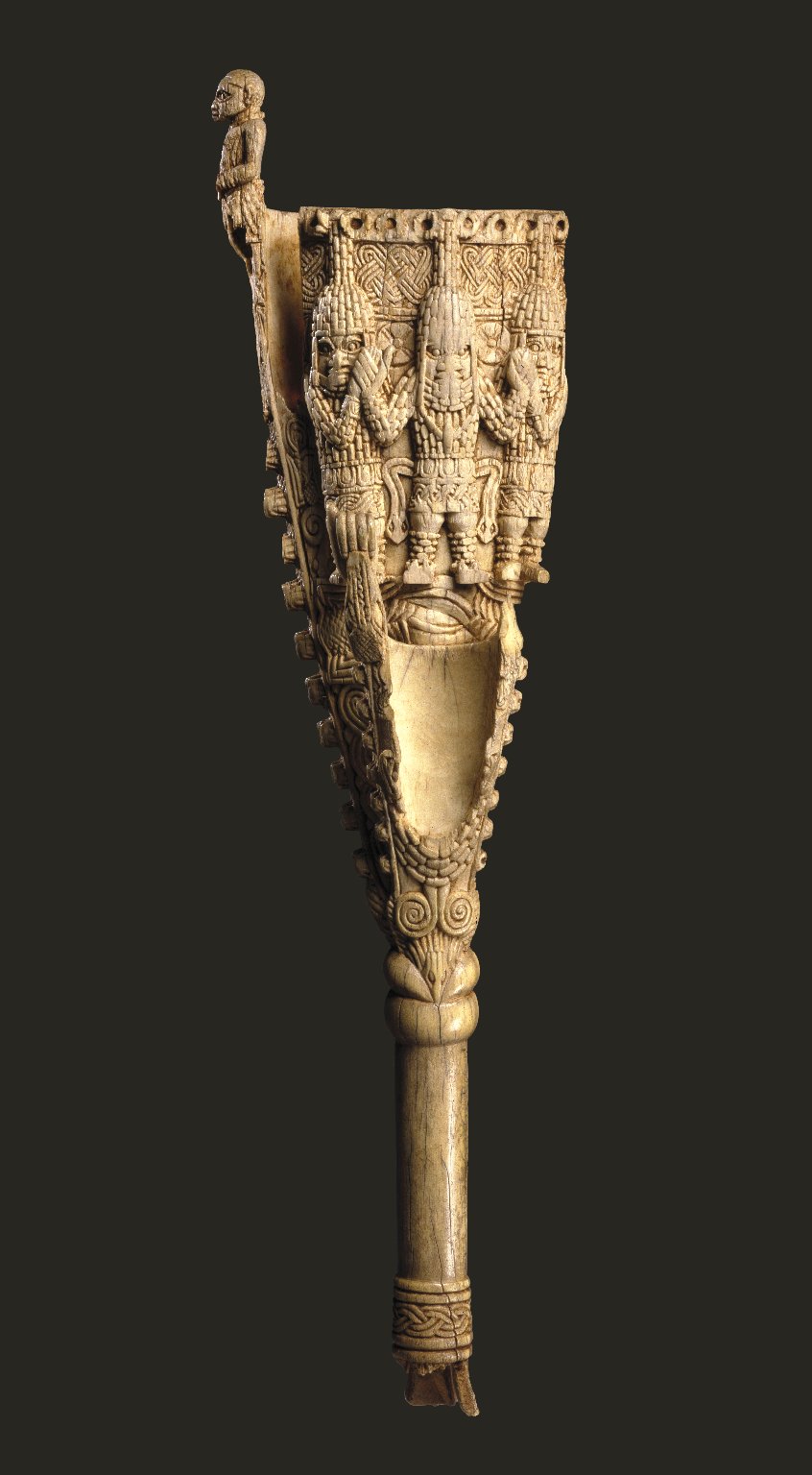 | 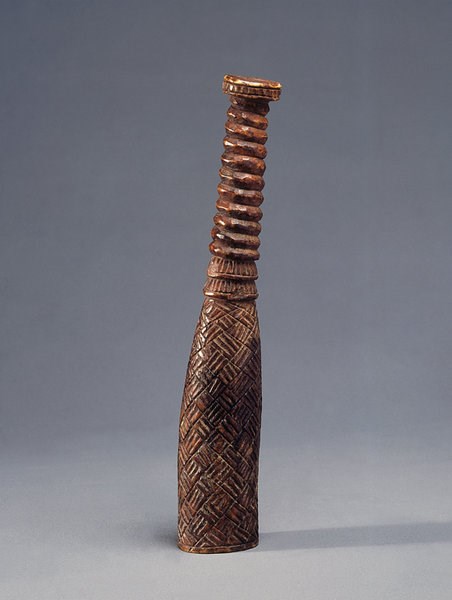 | 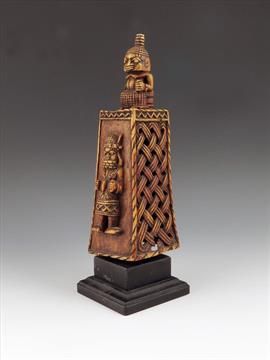 | 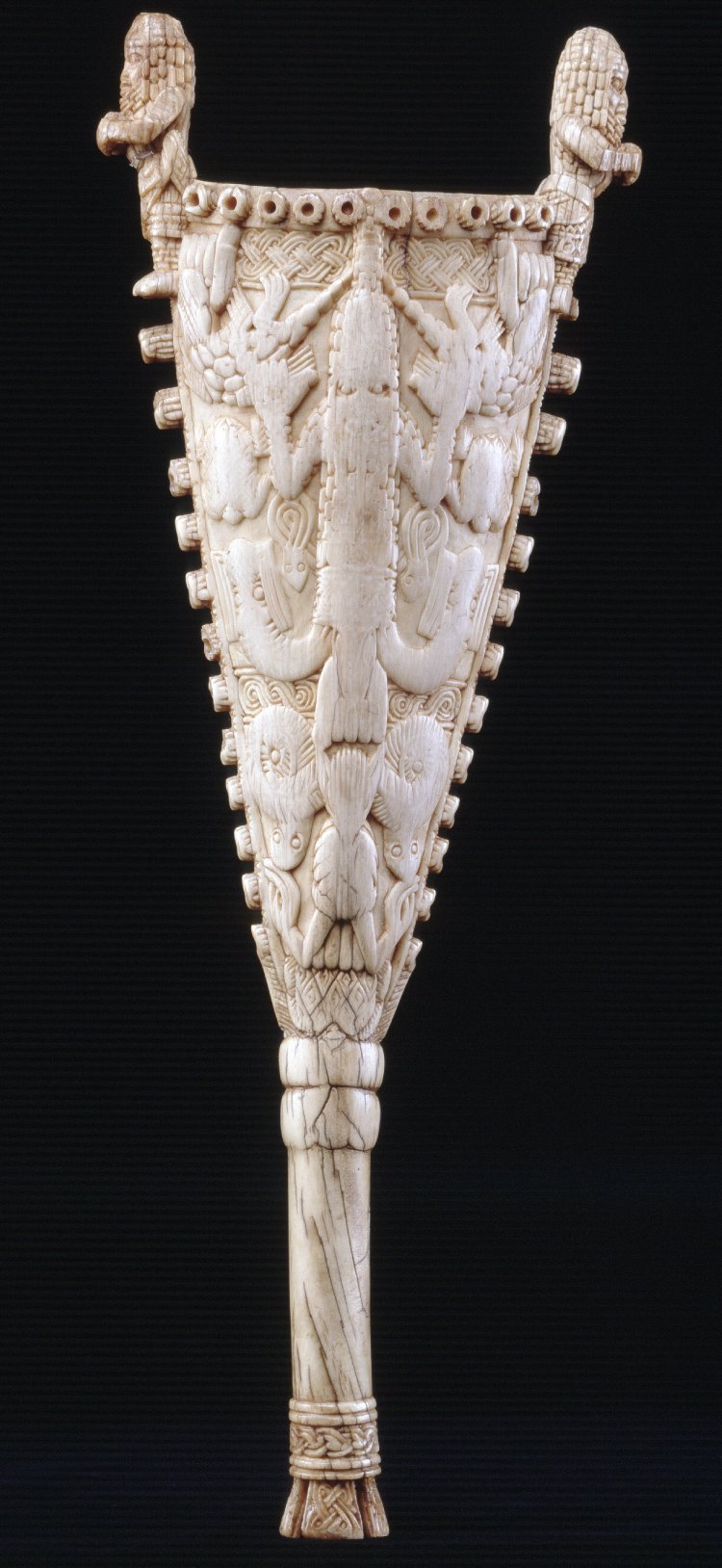 |
|---|---|---|---|
| Benin Ivory Double Bell | Benin Ritual Ivory Bell | Rectangular Benin Ivory Bell | Benin Bell British Museum |
The Oba of Benin held an Ivory bell along with an Ivory stick in each hand. The images displayed on the bells are both geometric design and figurative. 
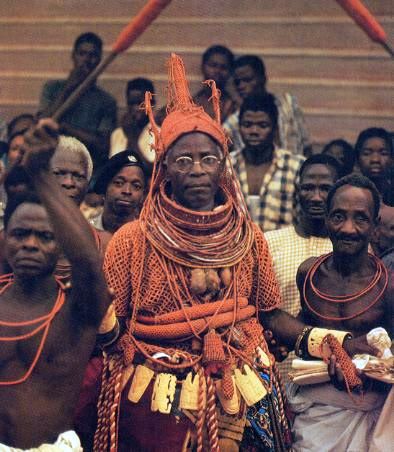 |
|---|
| Benin / Edo Oba and His Belt of Ivory Ornaments |
The title “Queen Mother” can be very, very confusing in reference to African culture. The only thing consistent about the queen mother is that she is somebody’s mother. In Benin culture “Queen Mother” is personal; it is literally the King’s (or Oba-s) mother (mama’s boy), that is if he chooses to seek his mother as council. Among the Ashanti the Queen mother has nothing to do with an Asantehene-s (or King’s) biological mother. Queen mother is more likely to be the kings distant cousin, sibling aunt or could be a nice. Queen Mother is public interest. Among the Ashanti Queen Mother is symbolically, spiritually and literally the mother of an entire Nation of people; therefore the Ashanti people must never be without a Queen Mother. Among the Ashanti the Ashantehene has no right to appoint a Queen Mother. A council appoints the Queen Mother and the Queen Mother with the aid of council appoints the Asantehene. If the Queen Mother dies during the Ashantehene term of office the council will install a new one. The Ashantehene ain’t got no say in it. The matter is out of his hands. If an Oba-s mother dies that is it; unless the Oba has a grandmother. His subjects have nothing to do with the Oba-s missing mother. That is his problem, because the people have biological mothers of their own. The following quote is taken from Nairaland Forum at nairaland.com: 
“The towering coral headdress is an important adornment of the so-called Queen Mother, an appellation that hearkens back to Oba Esigie, who ruled until 1550. Esigie is said to have conferred the title Iyoba (Queen Mother) upon his mother Idia out of gratefulness and respect and to have thereupon inaugurated this type of representation. Since then, all Obas have had the right to grant their mothers the official title Iyoba three years after their enthronement, though only 17 of the 38 Obas of the current dynasty have done so. In general, the Oba never again sets eyes upon his mother once he has assumed his title. As Iyoba, however, the Oba's mother is the only woman to occupy one of the highest posts in Benin, meaning that her son, the Oba, can consult with her on all matters of state. Conferring the title is thus a particularly important decision. After a Queen Mother's death, the Oba dedicates an entire altar to her to which he brings yearly sacrifices in her honour. He also erects a shrine devoted exclusively to her either in the royal palace or at the Iyoba's residence in Uselu, filling it with corresponding memorial heads”.
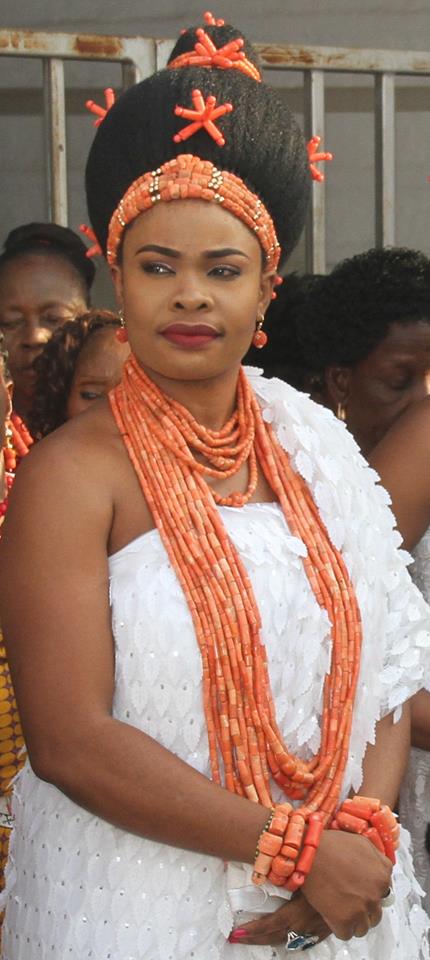
| Top | Benin Oba | Edo City/ Benin City | Benin Court Art | Igodomigodo | Iner-city Maze Network |
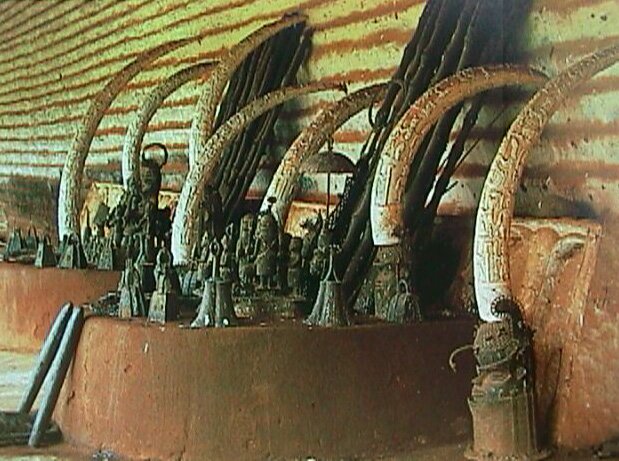 | 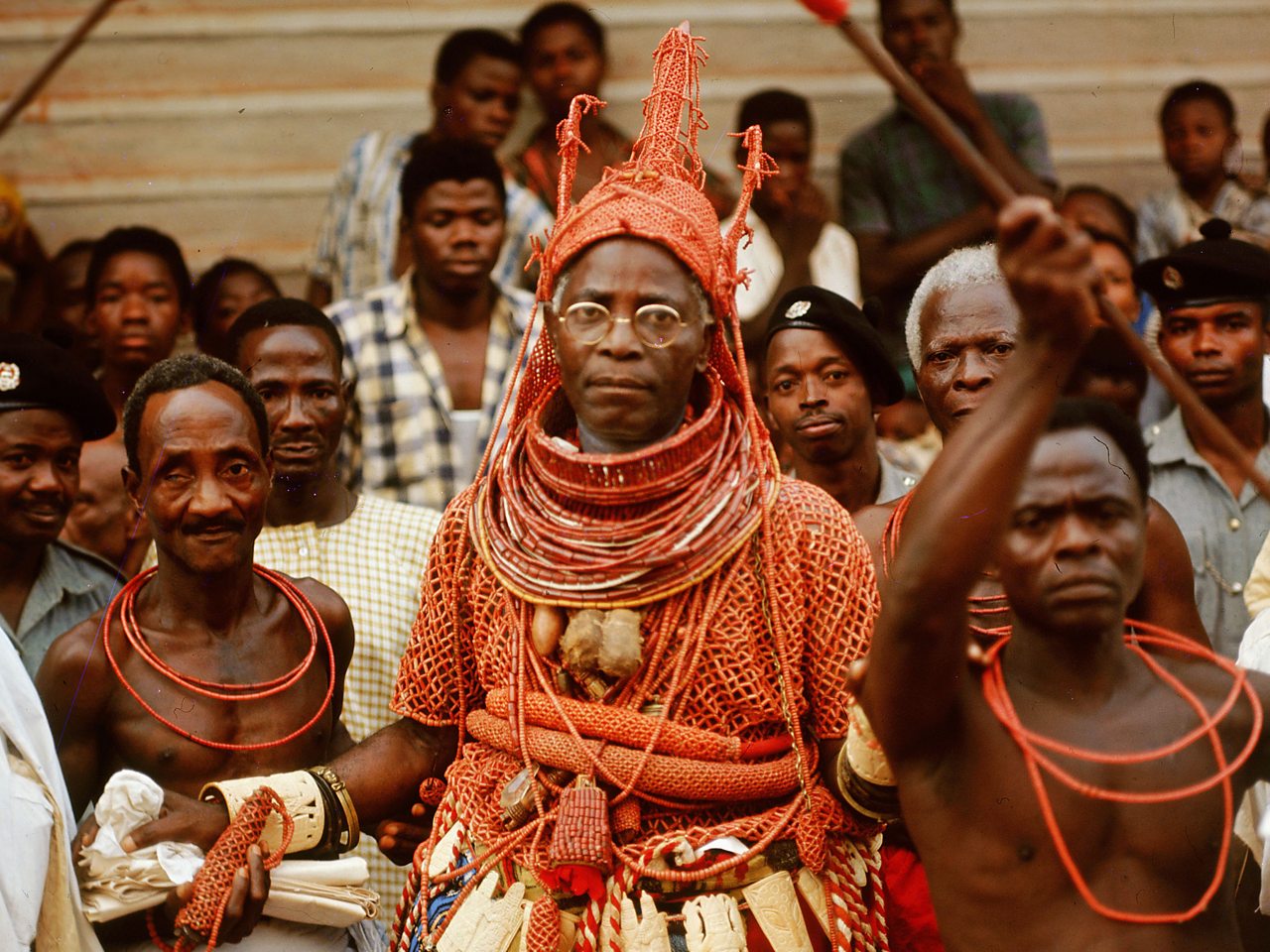 |
|---|
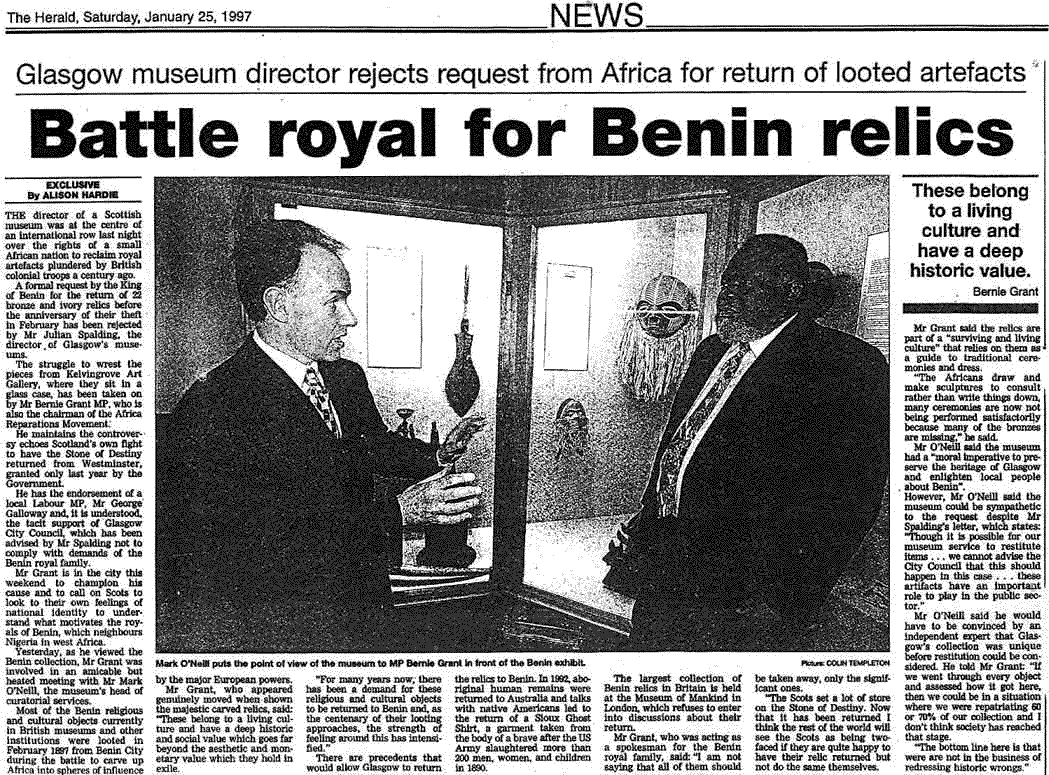 |
|---|
Most likely Nigeria will receive long term loan of Benin bronzes rather than purchases or gifts from Europe and America. Loans cost money. That means extra revenue in Europe’s pocket rather than Nigeria. Europe stands to make a fortune in the years to come. Nigeria won’t make a dime from its own heritage, which means more pussy for the imperialist. © Claude Lockhart Clark 10/04/2019 
MONEY FRAUD, COPYRIGHT AND PUBLISHING VIOLATIONS
Europe is pushing for a “deal/steal” of a lifetime. Stealing art and money is apart of their mindset and culture. Europeans steal from each other, so why would they behave any different concerning African things. When dealing with Europeans and America always keep in mind you are negotiating with two very cleaver kleptomaniacs. They continue to find ways to control the African mind the same as parent controls a child’s mind, “paternalism”. They manage to some how get Africans to comply with their strict rules and regulations. Europe will dictate the kind of museum Nigeria “must” build for them in Nigeria to house “European owned Edo bronzes”. The museum will be built using Nigerian money to house Benin bronzes confiscated by Europeans. This building will serve as a vault to secure treasures from “theft”. Nigerians will agree to leases covering an “indefinite” loan. © Claude Lockhart Clark, Oct. 07, 2019
What defines a museum?
A museum (/mju zi:em/ mew-ZEE-am; plural museums or, rarely, musea) is an institution that cares for (conserves) a collection of artifacts and other objects of artistic, cultural, historical, or scientific importance.
Do museums pay for items?
Most commonly, museums get the artifacts they need for an exhibit by either buying or borrowing them. Common sense would say that it is cheaper to borrow than buy, but in the world of museums that isn't always true. ... Museum curators locate and evaluate potential artifact acquisitions. Aug 4, 2015 © Google 
What is a museum loan?
DEFINITION: Loans are temporary transfers of objects from one institution to another in which there is no transfer of ownership. The Museum sends and receives loans for the purposes of exhibition, research (including destructive sampling, conservation, or study), or education.May 20, 2009 © Google
How much do museum exhibits cost?
The majority of the responses are for exhibition between 1000 square feet and 5000 square feet (67.9% total). The per square foot costs were grouped in three ranges $25-$75 per square foot (25.5% total), $100-$150 per square foot (30.6% total), $250-$350 per square foot (25.5% total). Jul 18, 2011 © Google
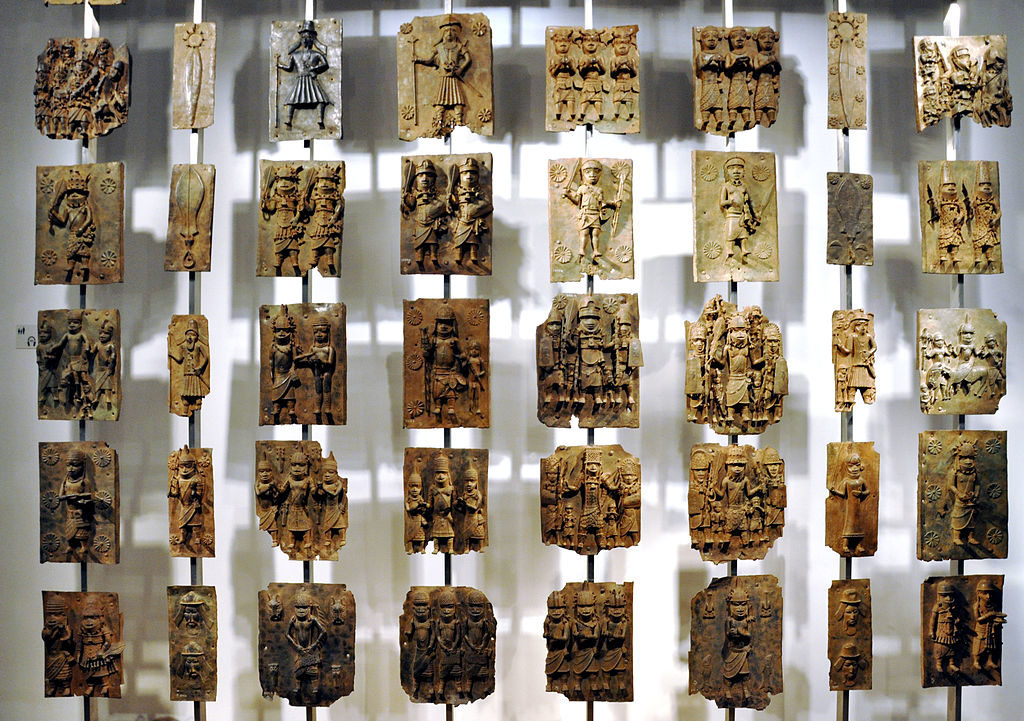 |
||||||||||
|---|---|---|---|---|---|---|---|---|---|---|
| ClaudeClark.org | Educ. | African | Kuba Art | African Studies | Art | Bambara | Igbo | Yoruba |Akan Art | |
| Top |16th Century Edo Western Art | Benin Court Art | Edo City/ Benin City | Igodomigodo | Iner-city Maze Network |
| |Benin Oba | Stolen Legacy | Carnage | Benin Heritage |
Benin / Edo Cast Brass Plaques From Benin City at British Museum in London England Great Britain |
|---|
| GRAND THEFT OF AN ENTIRE SCULPTURED HISTORY & ITS ECONOMIC WEALTH |
Most likely Nigeria will receive long term loan of Benin bronzes rather than purchases or gifts from Europe and America. Loans cost money. That means extra revenue in Europe’s pocket rather than Nigeria. Europe stands to make a fortune in the years to come. Nigeria won’t make a dime from its own heritage, which means more pussy for the imperialist. © Claude Lockhart Clark 10/04/2019 Europe is pushing for a “deal/steal” of a lifetime. Stealing art and money is apart of their mindset and culture. Europeans steal from each other, so why would they behave any different concerning African things. When dealing with Europeans and America always keep in mind you are negotiating with two very cleaver kleptomaniacs. They continue to find ways to control the African mind the same as parent controls a child’s mind, “paternalism”. They manage to some how get Africans to comply with their strict rules and regulations. Europe will dictate the kind of museum Nigeria “must” build for them in Nigeria to house “European owned Edo bronzes”. The museum will be built using Nigerian money to house Benin bronzes confiscated by Europeans. This building will serve as a vault to secure treasures from “theft”. Nigerians will agree to leases covering an “indefinite” loan. © Claude Lockhart Clark, Oct. 07, 2019 |
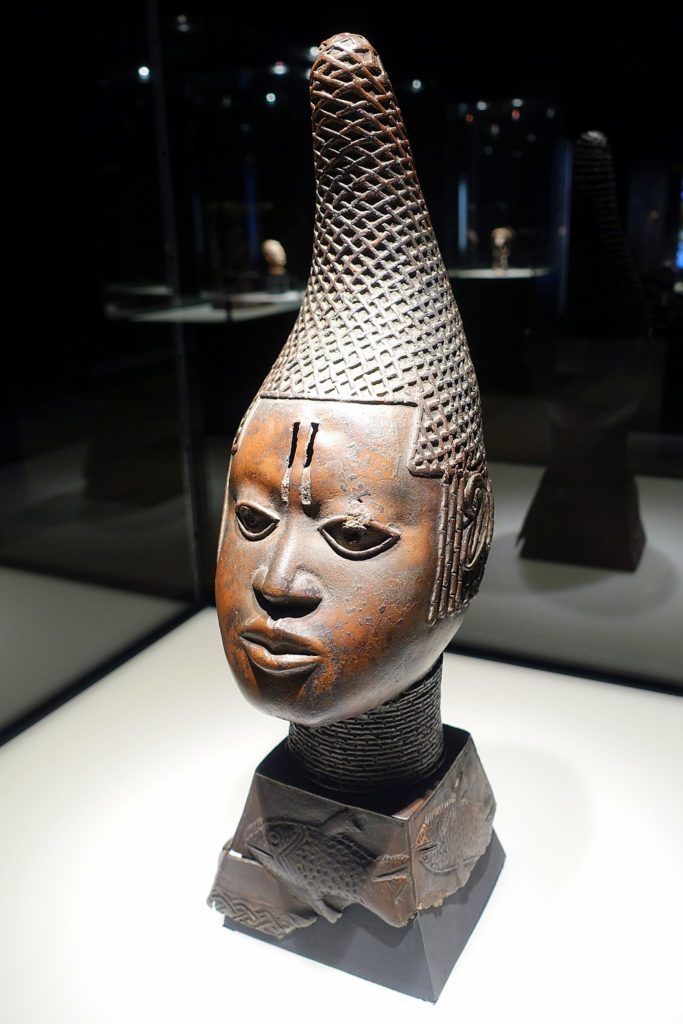 |
| Benin/Edo Queen Mother cast in Gunmetal Bronze Ethnological Museum Berlin Germany |
Most likely Nigeria will receive long term loan of Benin bronzes rather than purchases or gifts from Europe and America. Loans cost money. That means extra revenue in Europe’s pocket rather than Nigeria. Europe stands to make a fortune in the years to come. Nigeria won’t make a dime from its own heritage, which means more pussy for the imperialist. © Claude Lockhart Clark 10/04/2019 
Europe is pushing for a “deal/steal” of a lifetime. Stealing art and money is apart of their mindset and culture. Europeans steal from each other, so why would they behave any different concerning African things. When dealing with Europeans and America always keep in mind you are negotiating with two very cleaver kleptomaniacs. They continue to find ways to control the African mind the same as parent controls a child’s mind, “paternalism”. They manage to some how get Africans to comply with their strict rules and regulations. Europe will dictate the kind of museum Nigeria “must” build for them in Nigeria to house “European owned Edo bronzes”. The museum will be built using Nigerian money to house Benin bronzes confiscated by Europeans. This building will serve as a vault to secure treasures from “theft”. Nigerians will agree to leases covering an “indefinite” loan. © Claude Lockhart Clark, Oct. 07, 2019
Berlin knows that England was and still is an art heritage predator, yet they sought the panhandler out and bought stolen goods anyway. Berlin and the Germans are guilty of accessory to a crime and guilty of knowing England was peddling stolen property. The Britains claimed that they took booty as punishment for “misbehavior” and war damages. There were no damages. The damage that England missed getting was a broken foot up its damn ______ . 
For more details be sure to read the following articles: Benin’s Looted Bronzes Are All Over the Western World and Europe’s Largest Museums Will Loan Looted Benin Bronzes.
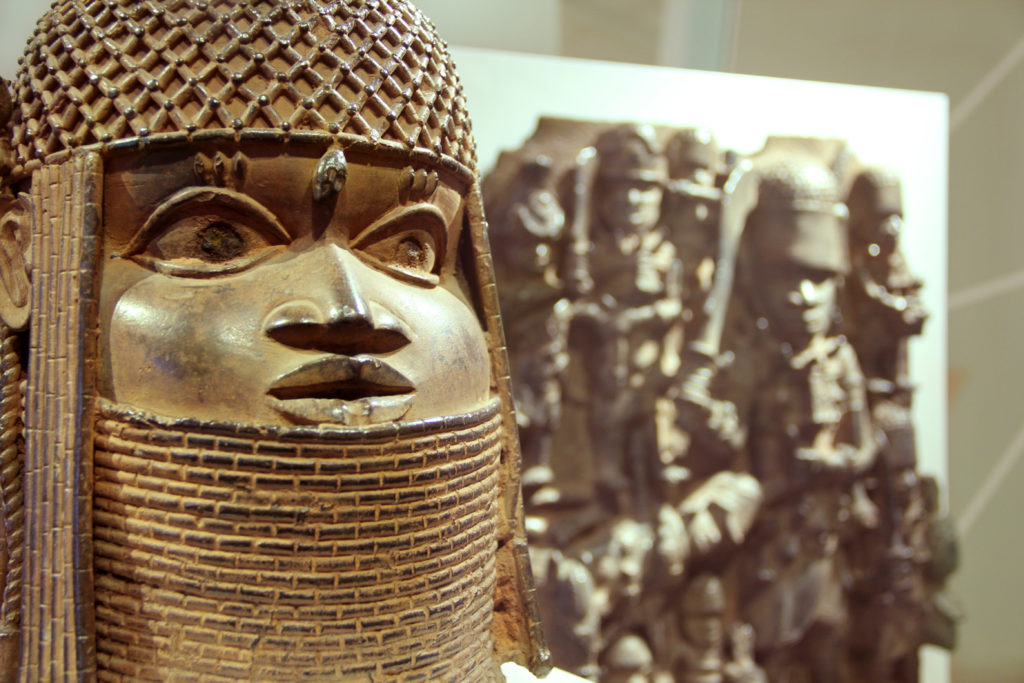
Most likely Nigeria will receive long term loan of Benin bronzes rather than purchases or gifts from Europe and America. Loans cost money. That means extra revenue in Europe’s pocket rather than Nigeria. Europe stands to make a fortune in the years to come. Nigeria won’t make a dime from its own heritage, which means more pussy for the imperialist. © Claude Lockhart Clark 10/04/2019 
Hamburg knows that England was and still is an art heritage predator, yet they sought the panhandler out and bought stolen goods anyway. Berlin and the Germans are guilty of accessory to a crime and guilty of knowing England was peddling stolen property. The Britains claimed that they took booty as punishment for “misbehavior” and war damages. There were no damages. The damage that England missed getting was a broken foot up its ______ . 
Europe is pushing for a “deal/steal” of a lifetime. Stealing art and money is apart of their mindset and culture. Europeans steal from each other, so why would they behave any different concerning African things. When dealing with Europeans and America always keep in mind you are negotiating with two very cleaver kleptomaniacs. They continue to find ways to control the African mind the same as parent controls a child’s mind, “paternalism”. They manage to some how get Africans to comply with their strict rules and regulations. Europe will dictate the kind of museum Nigeria “must” build for them in Nigeria to house “European owned Edo bronzes”. The museum will be built using Nigerian money to house Benin bronzes confiscated by Europeans. This building will serve as a vault to secure treasures from “theft”. Nigerians will agree to leases covering an “indefinite” loan. © Claude Lockhart Clark, Oct. 07, 2019
For more details be sure to read the following articles: Benin’s Looted Bronzes Are All Over the Western World and Europe’s Largest Museums Will Loan Looted Benin Bronzes.
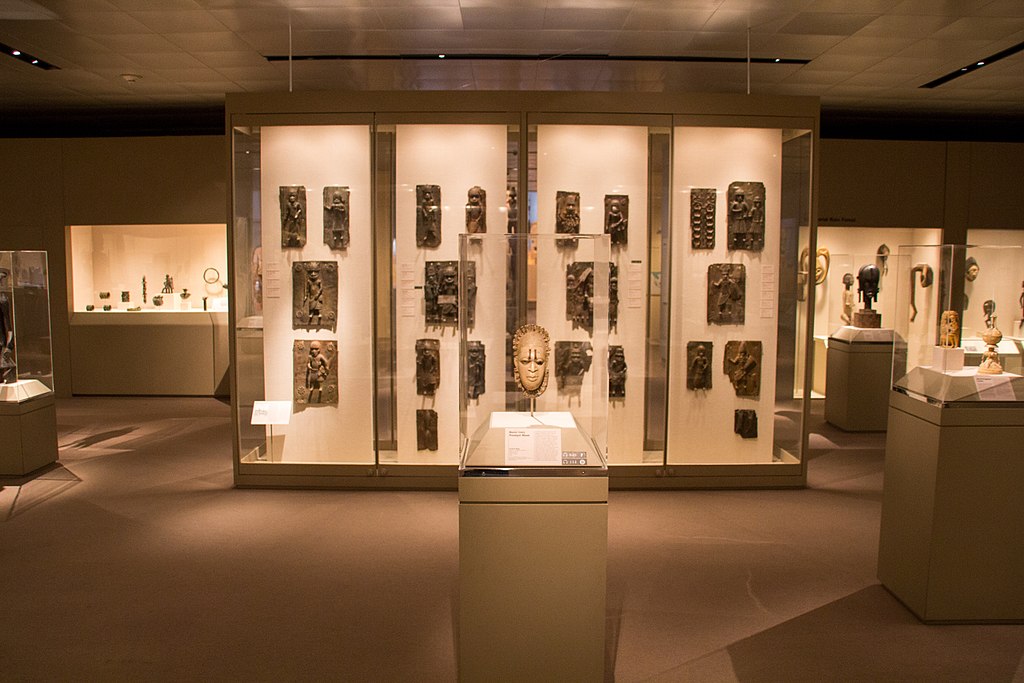
of Art New York City in United States of America North America
Yes America in it too. They play, pay patsy to Europe hoping that one-day America will be admitted prestigious membership into the European Union. Boy won’t that be the day. Americans can kiss them gold nuggets then worship the ground Europe walks on. That would be like having white icing on the cake. Only one problem the icing has too many raisins in it. Where are they going to put the raisins? Too many raisins; America needs to get rid of them raisins first. 
America sat in on the Berlin Conference to help Europe resolve some issues in order to avoid another European continent civil war like the Napoleon Wars. The purpose of the Berlin Conference was about how to preserve European Civilization. Members thought European civilization might collapse if they were involved in another civil war. The second European Civil War did occur and became a global conflict World War I. America created a League of Nations in order to prevent a third European Civil War and collapse of “Colonial (Western Civilization)”. A third civil war erupted soon after causing a second global conflict World War II. After that the United Nations was born to prevent the collapse of both European and Western Civilizations. Humans have been waiting with baited breath, ever since, hoping that World War II is the last global conflict.
American president Harry Truman develop the “Truman Plan” and put Secretary of State five-star general George Catlett Marshall’s name on the plan in order to get both houses in congress to pass it. American Business made a fortune off of the deal and Western European businesses were able to prosper from the results. Truman sent Five-star General Douglas Mac Arthur to Japan with a similar mission. It ending slightly difference with Japan using the plan to wage an economic war in place of the military war Japan lost in 1945. America finally beat Japan down economically during the later part of the 20th Century gaining an upper hand on the situation. 
America is the global bully of Europe and the Western World. Everyone is afraid of the worlds number one terrorist United Sates of America. At the beginning of the twenty second century America “pulled” three buildings on September 11, 2001 a date that will go down in euphony. She made it look like several countries in Western Asia did it. The third building contain Internal Revenue Records and insurance records on the two trade centers that were pulled. What country would allow such a dastardly job go unchallenged by its own populace? The answer is “A country nobody don’t want to dare mess with”. Remember see no evil, hear no evil and KEEP YOUR GOD DAMN TRAP SHUT. The federal government appropriated money to the Military Industrial Complex to build Home Land Security; something this country does not need.
Vice President Nelson Rockefeller a "philanthropist" and his son Michael Rockefeller, an anthropologist, were responsible for art collections at the Metropolitan and Primitive Art Museums in Manhattan (New York City).
Most likely Nigeria will receive long term loan of Benin bronzes rather than purchases or gifts from Europe and America. Loans cost money. That means extra revenue in Europe’s pocket rather than Nigeria. Europe stands to make a fortune in the years to come. Nigeria won’t make a dime from its own heritage, which means more pussy for the imperialist. © Claude Lockhart Clark 10/04/2019 
Europe is pushing for a “deal/steal” of a lifetime. Stealing art and money is apart of their mindset and culture. Europeans steal from each other, so why would they behave any different concerning African things. When dealing with Europeans and America always keep in mind you are negotiating with two very cleaver kleptomaniacs. They continue to find ways to control the African mind the same as parent controls a child’s mind, “paternalism”. They manage to some how get Africans to comply with their strict rules and regulations. Europe will dictate the kind of museum Nigeria “must” build for them in Nigeria to house “European owned Edo bronzes”. The museum will be built using Nigerian money to house Benin bronzes confiscated by Europeans. This building will serve as a vault to secure treasures from “theft”. Nigerians will agree to leases covering an “indefinite” loan. © Claude Lockhart Clark, Oct. 07, 2019
|
|

| My Blog List |
|---|
Ralph Bunche / An American Odyssey Promote Your Page Too |
|---|
 |  |
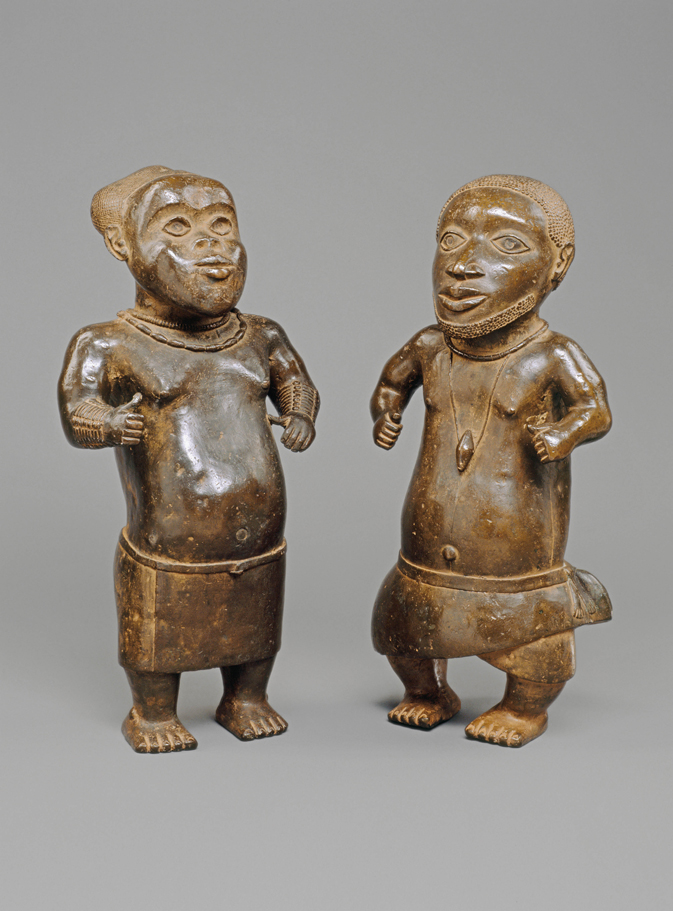
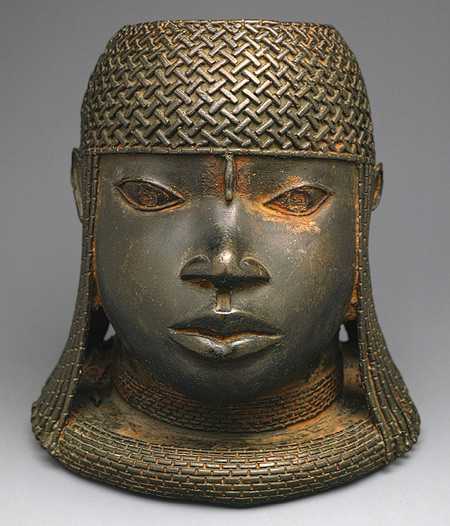
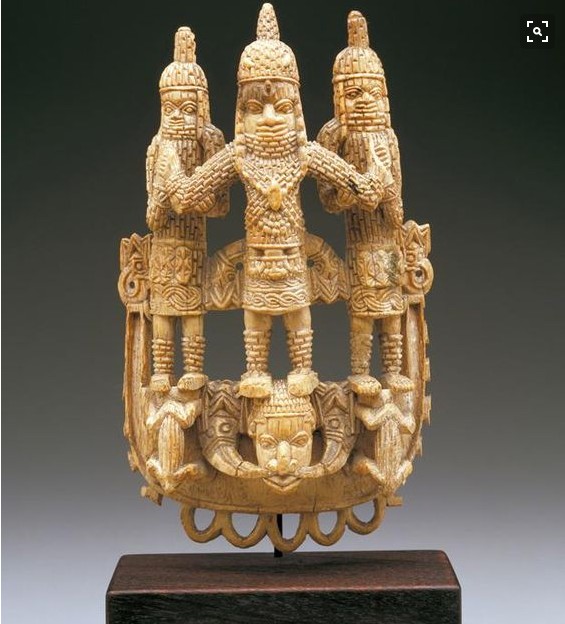
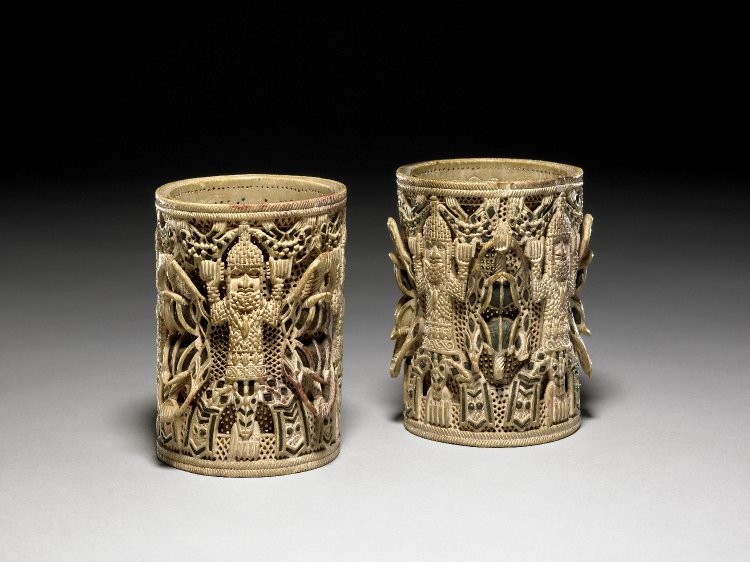
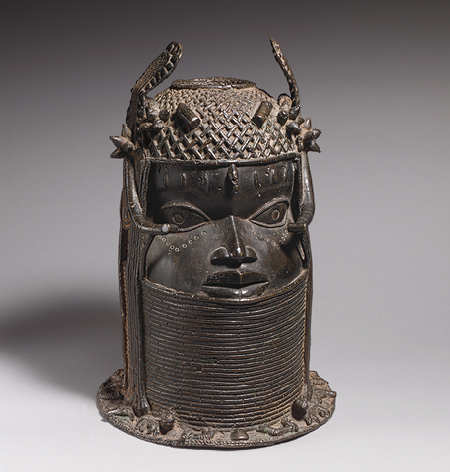
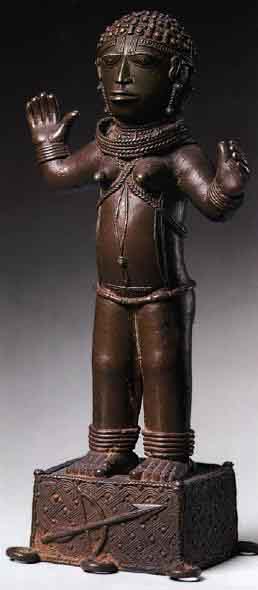
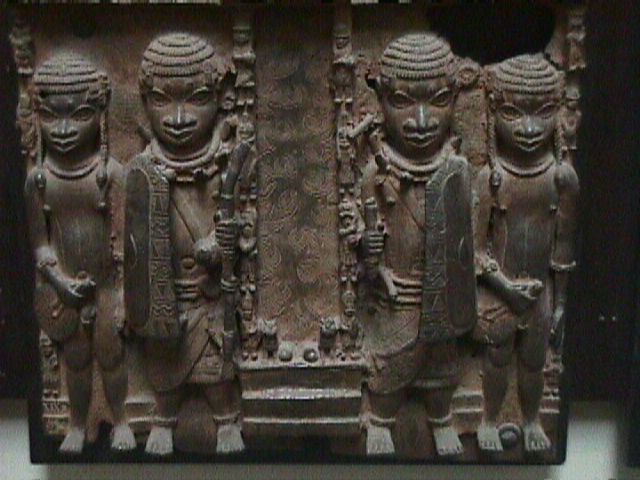
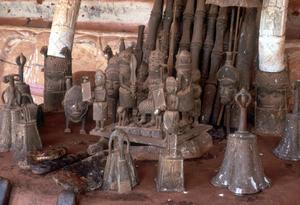
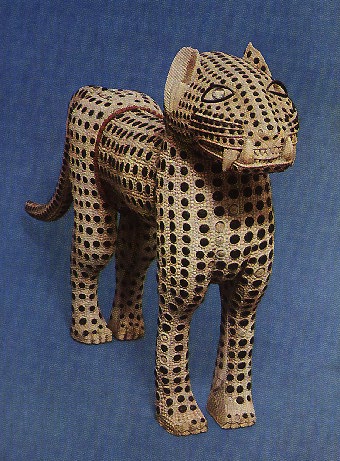
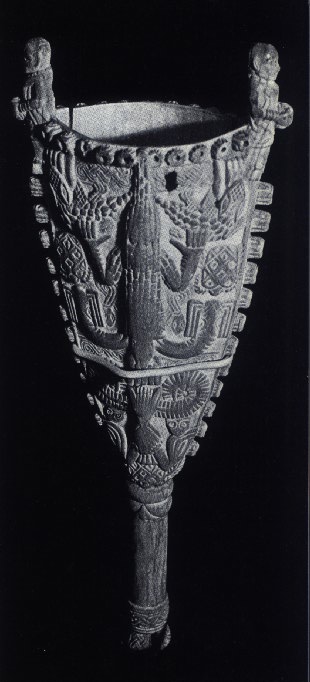
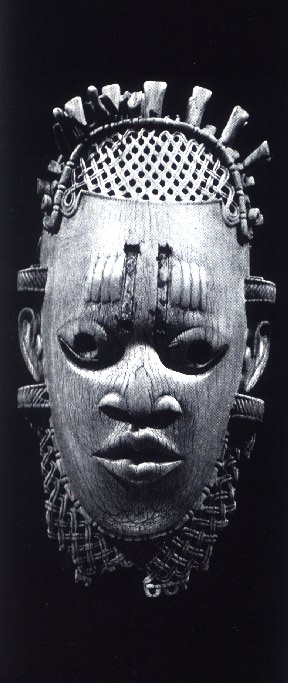
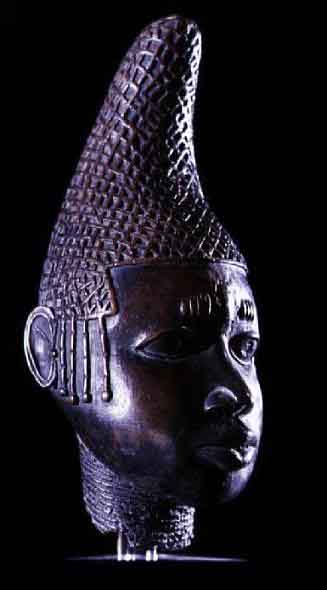
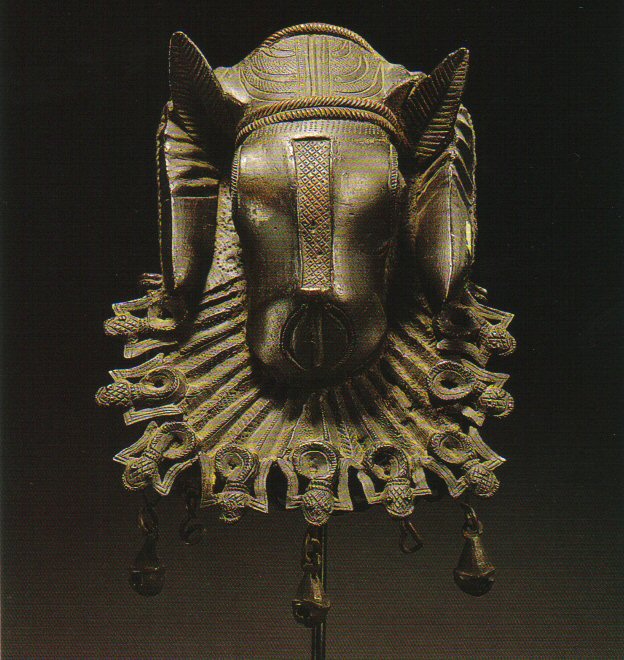
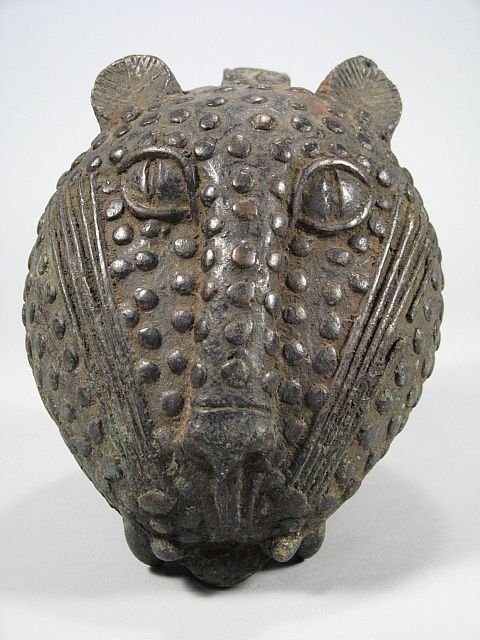
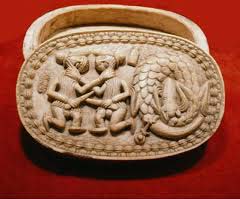
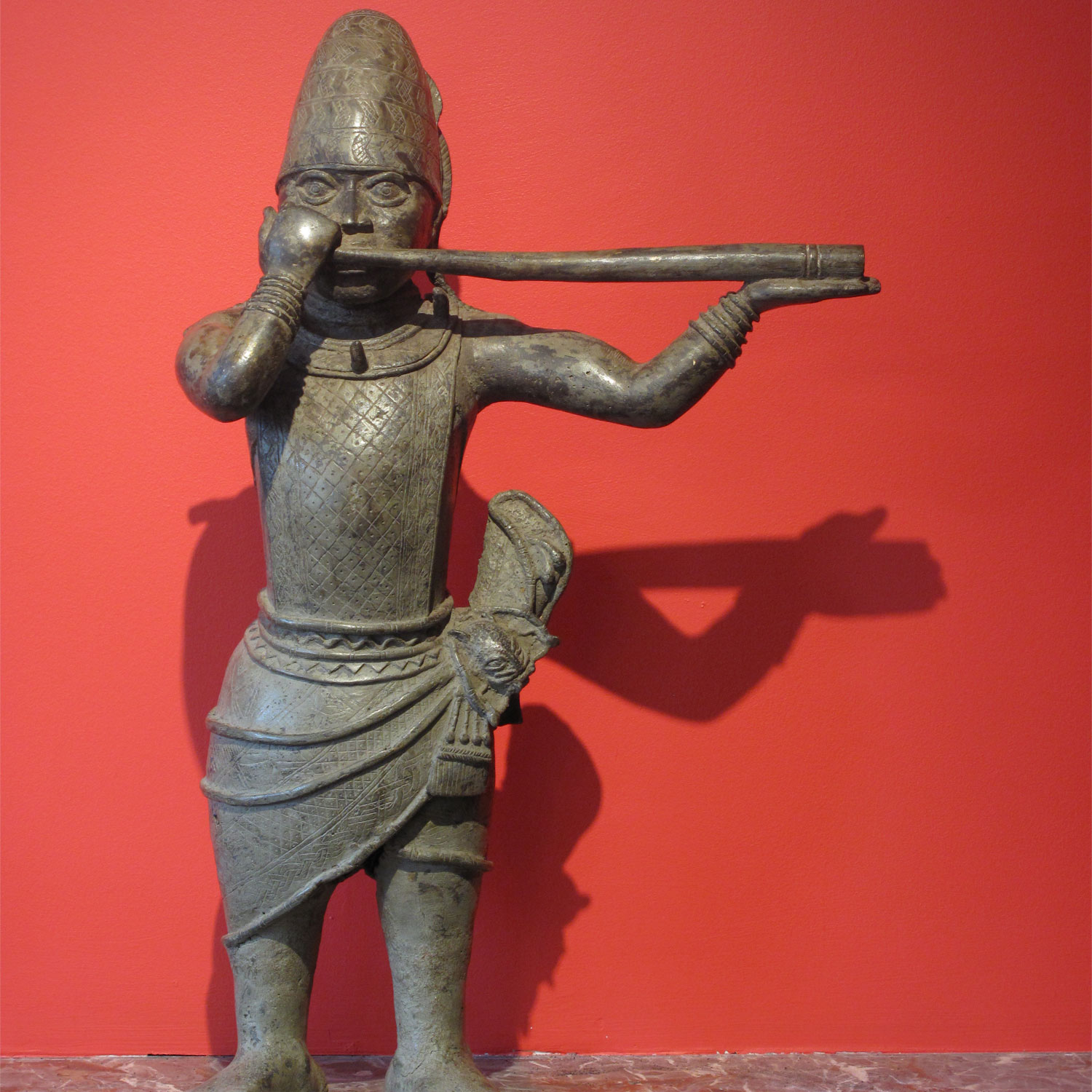
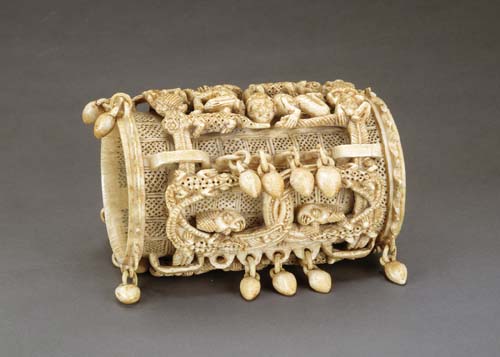
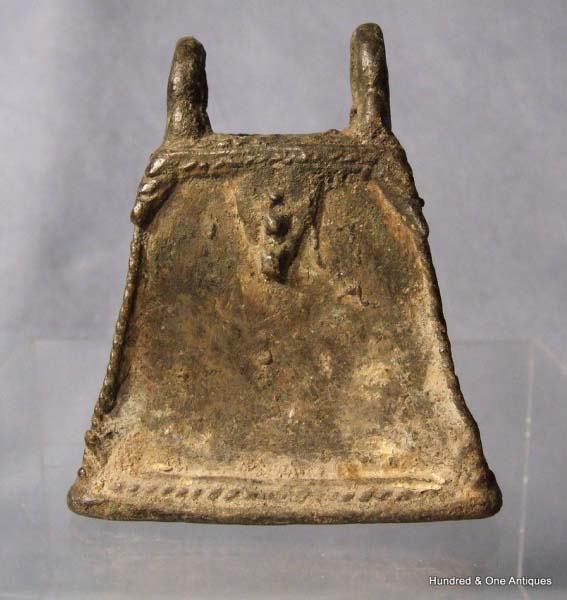

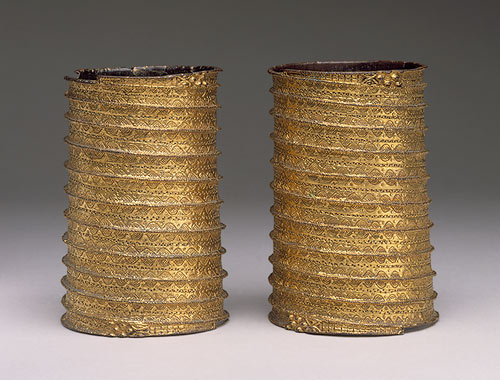
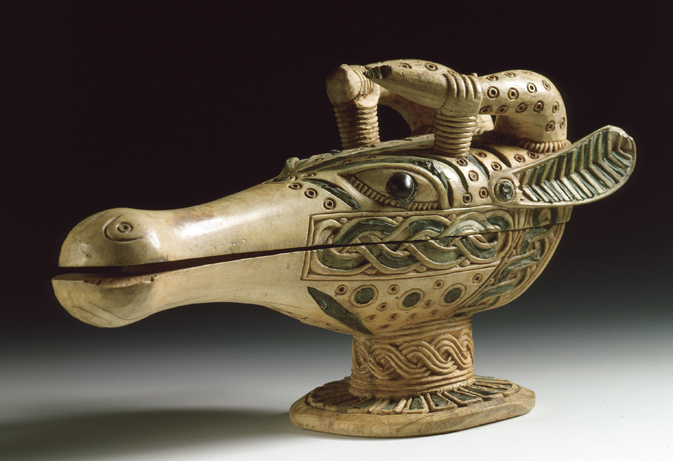
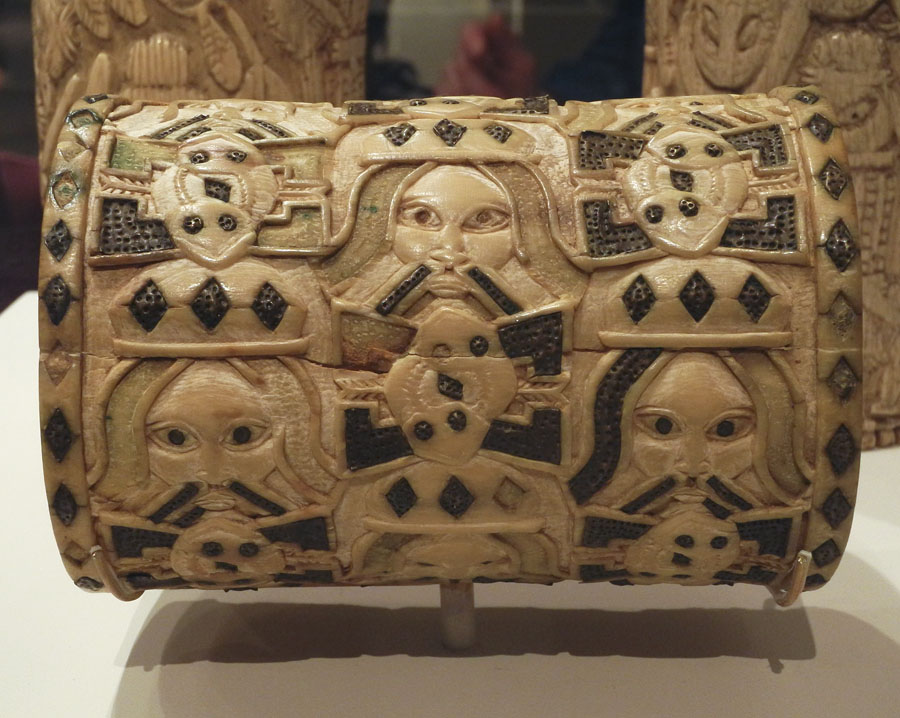
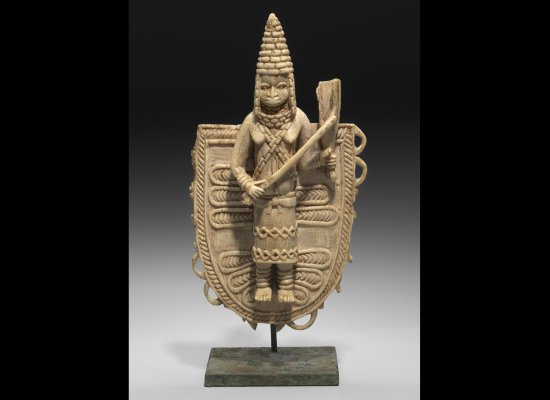
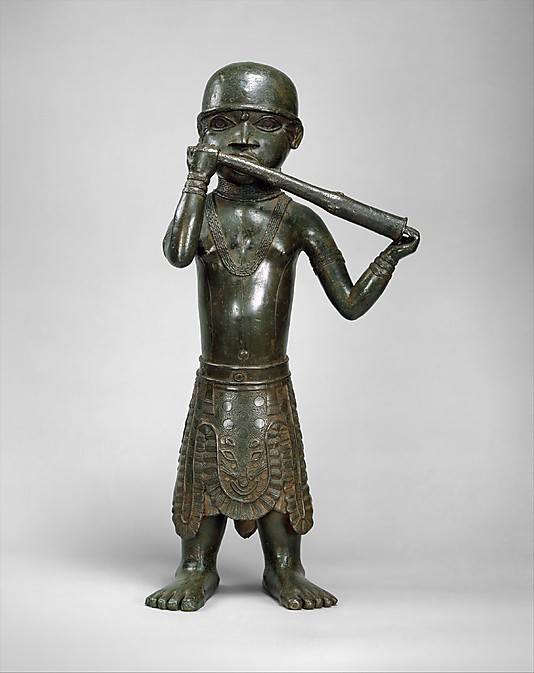
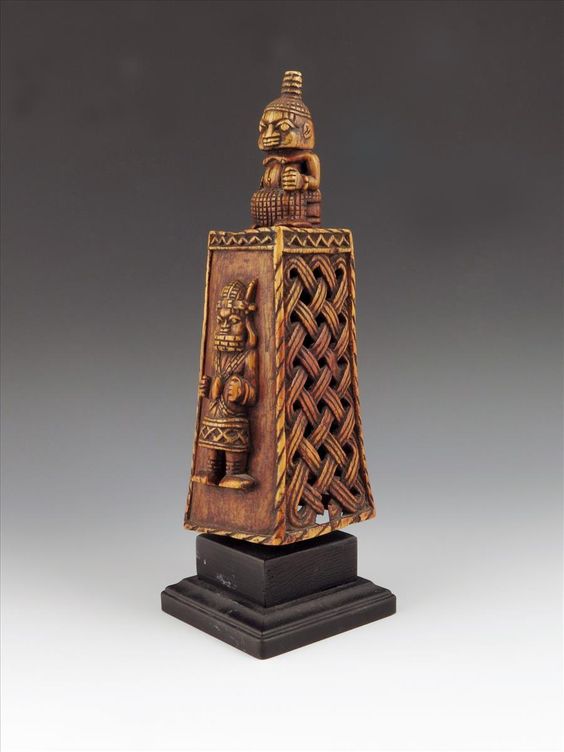
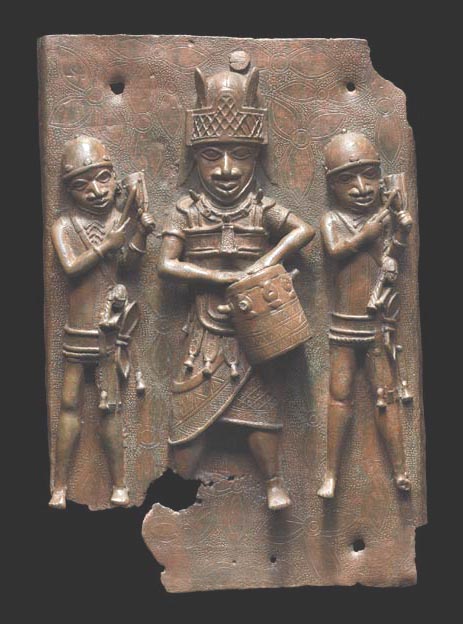
.jpg)
